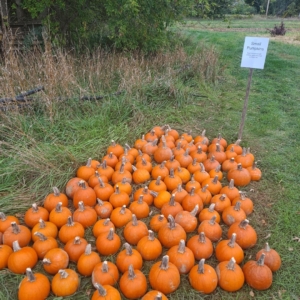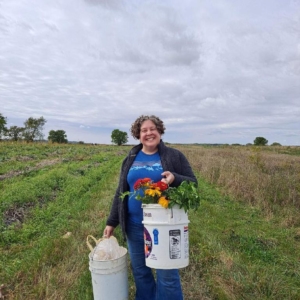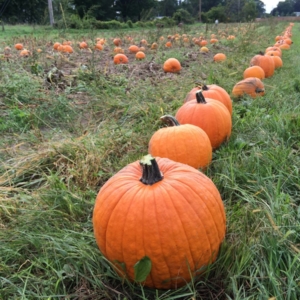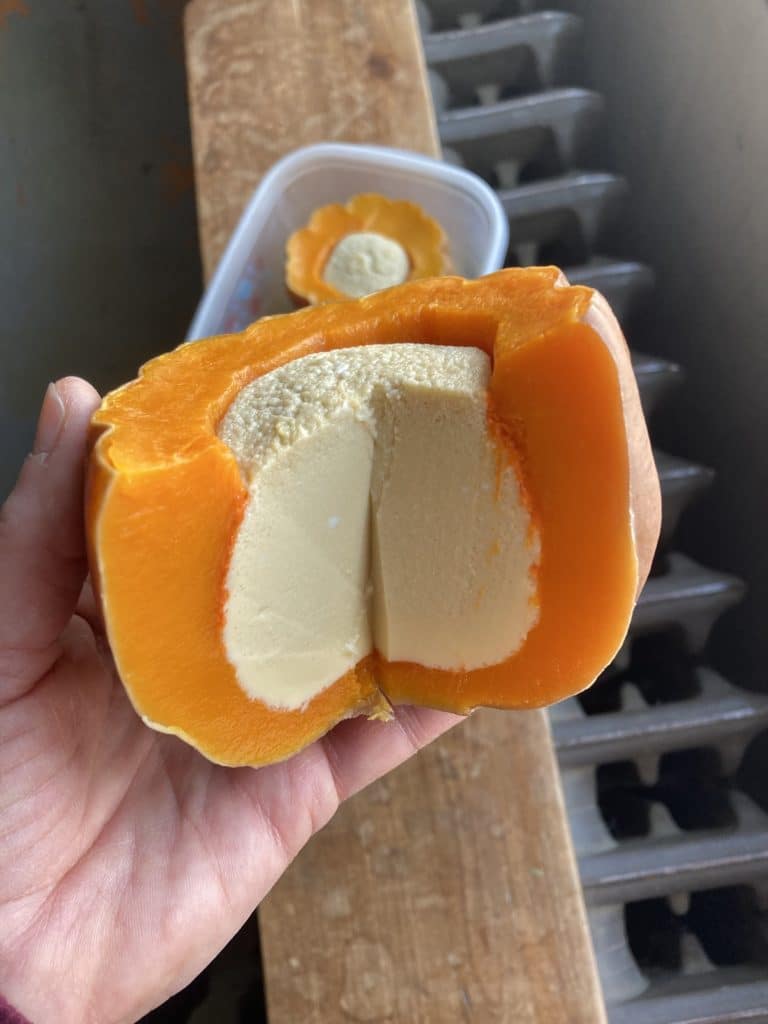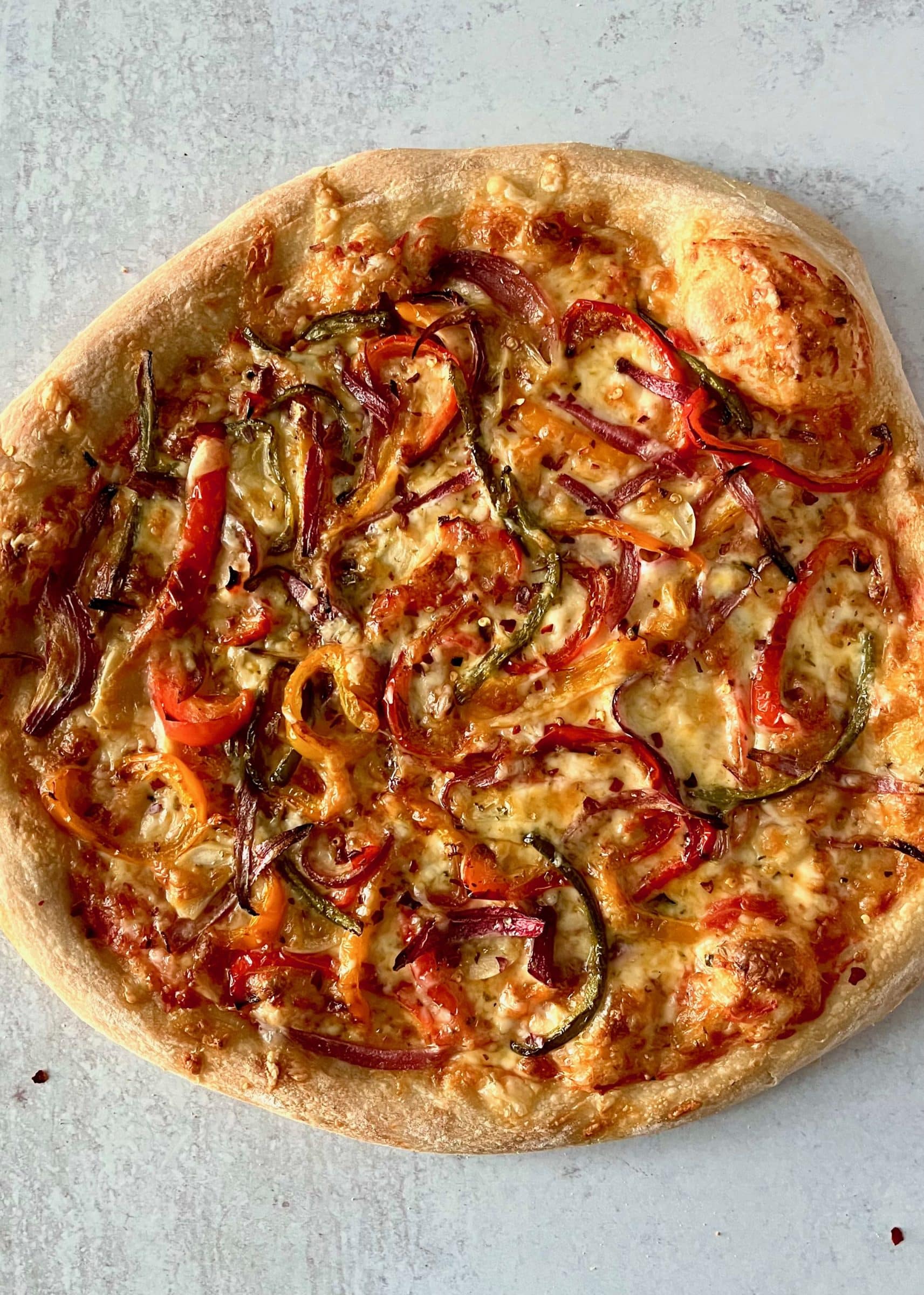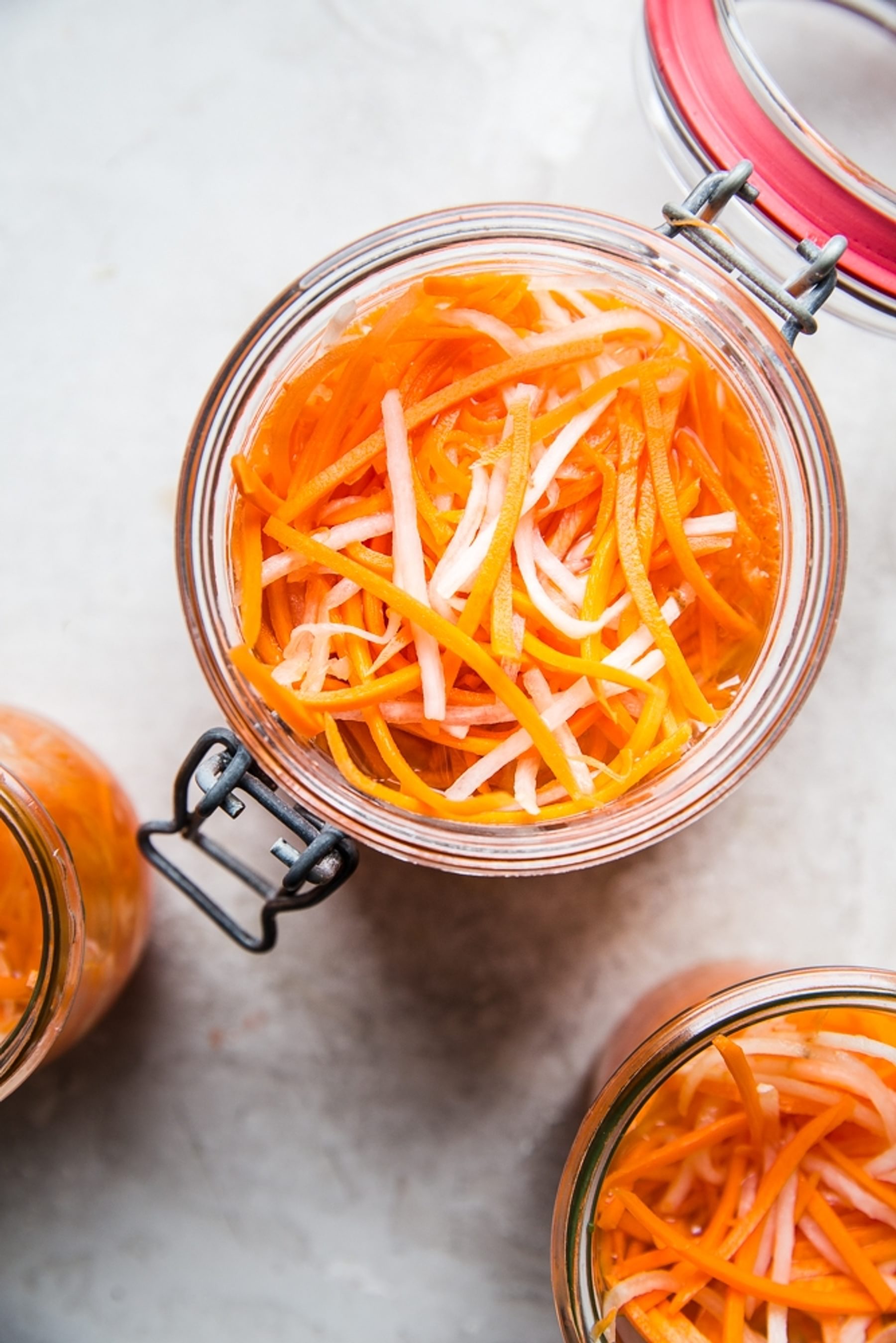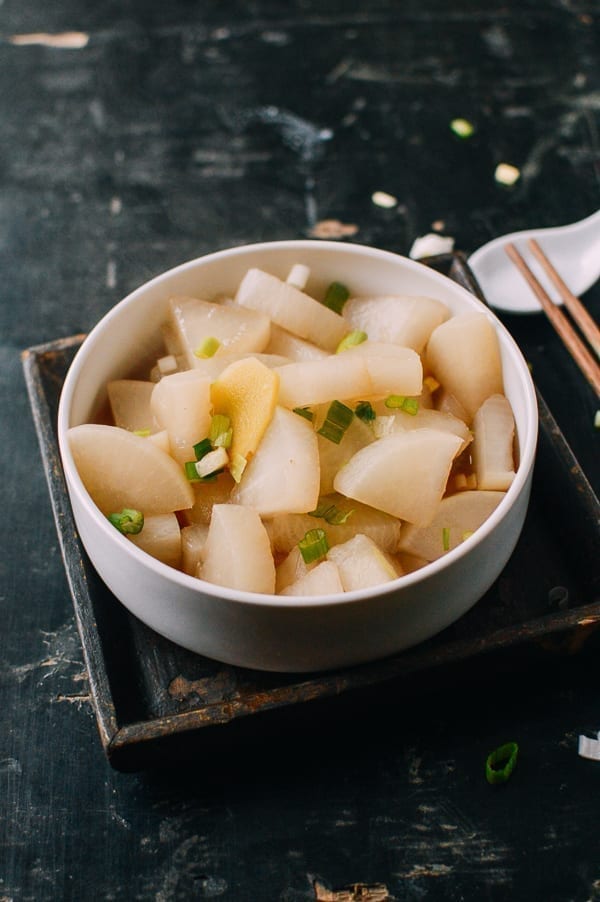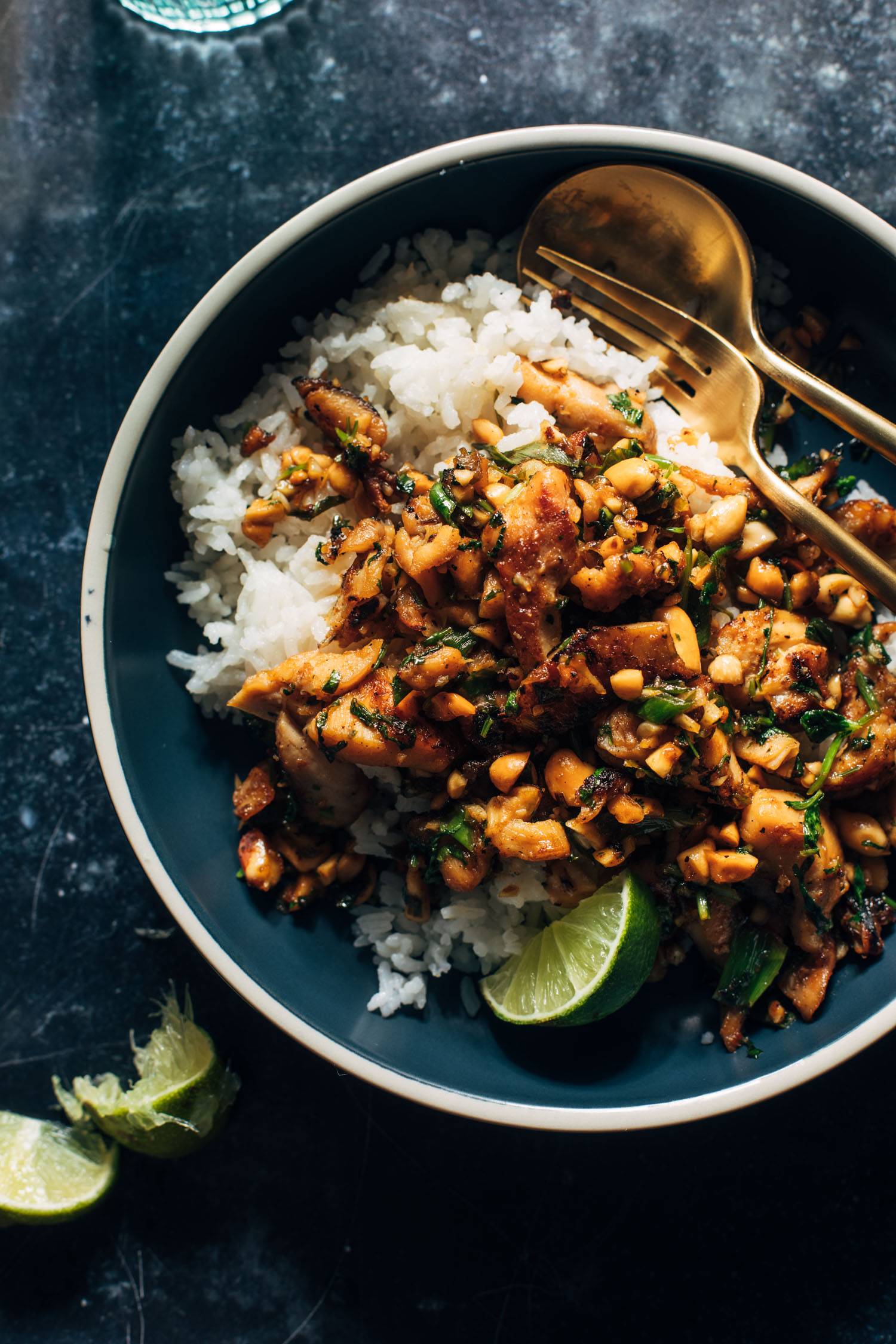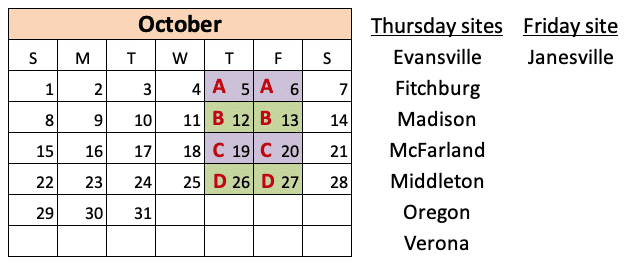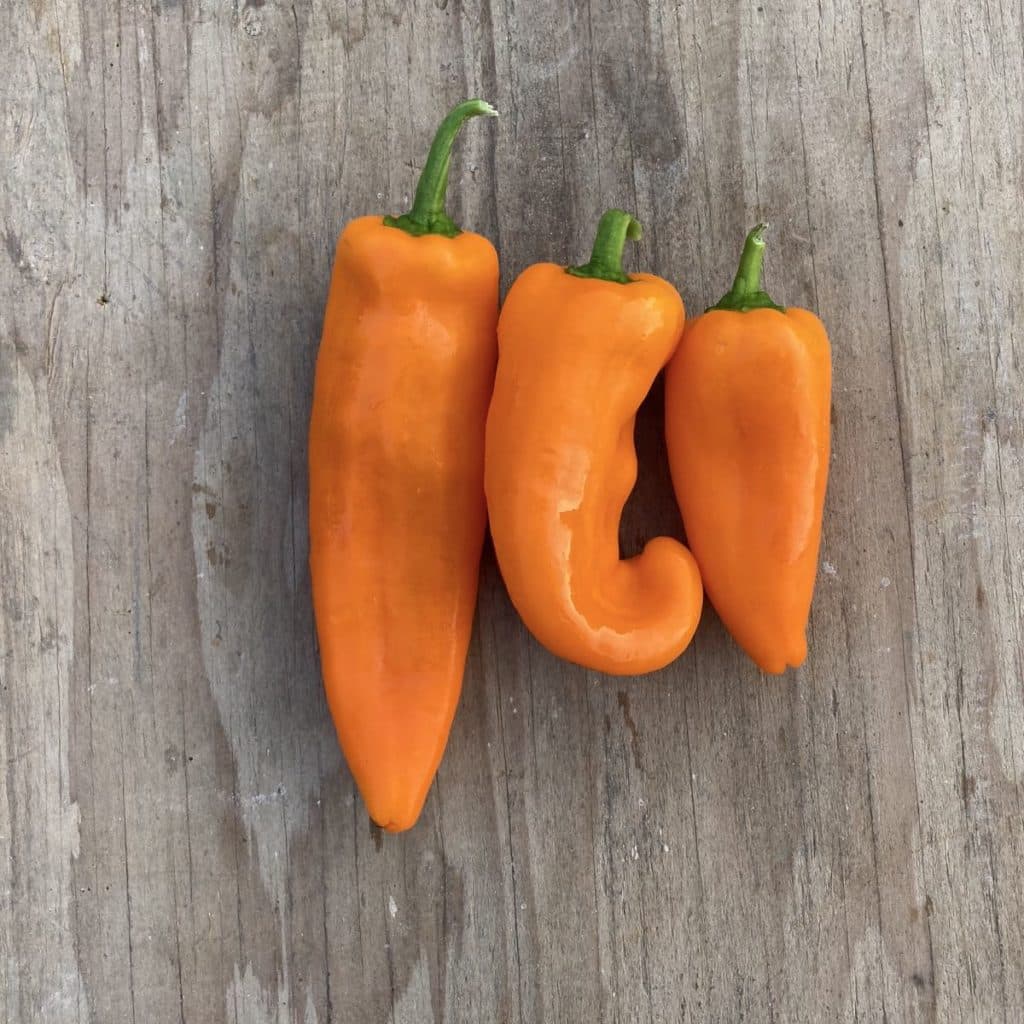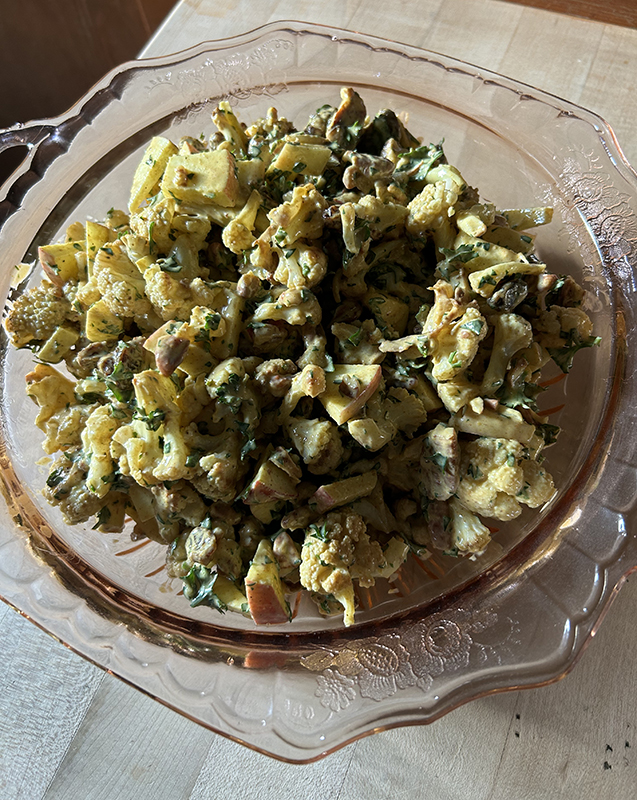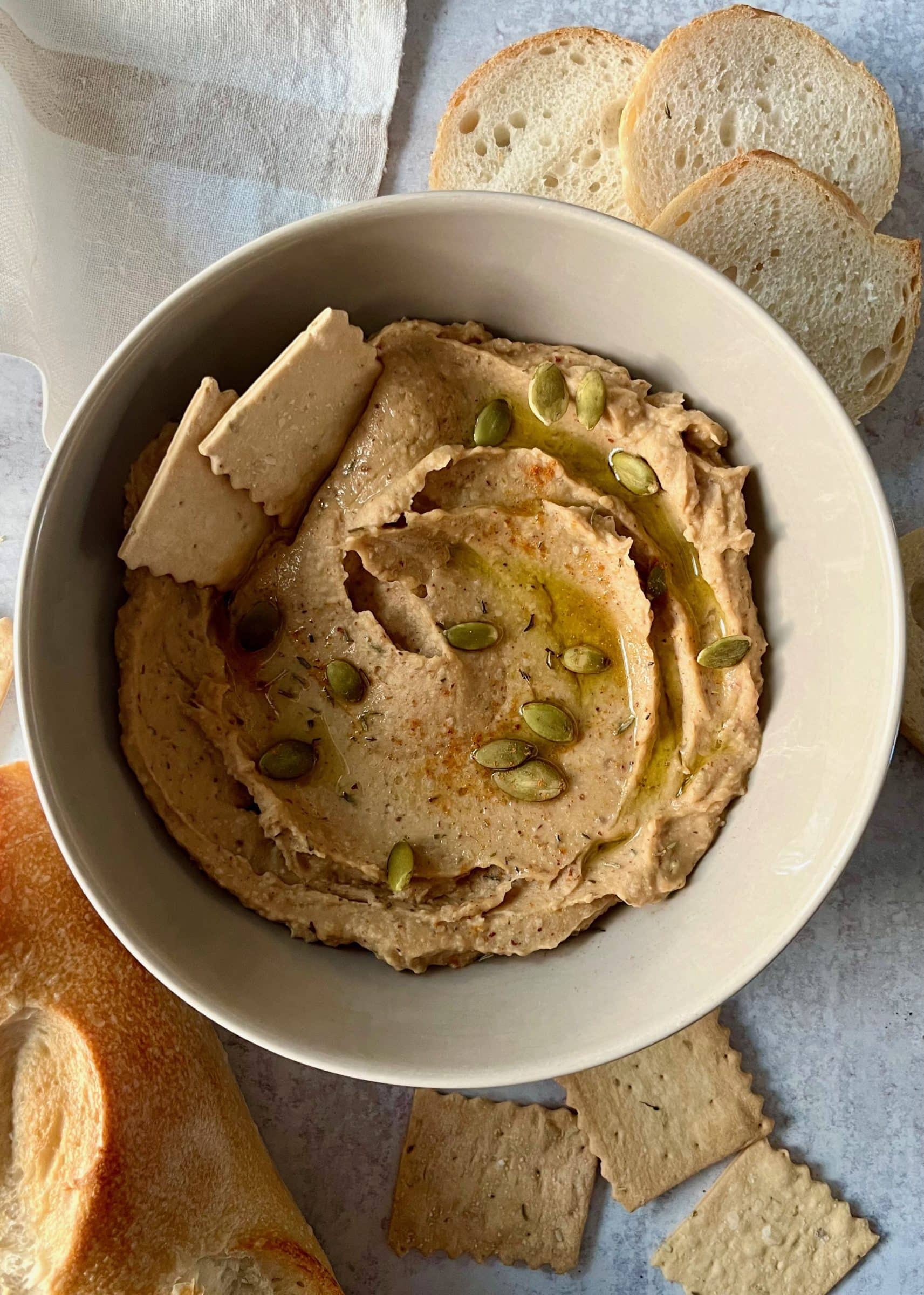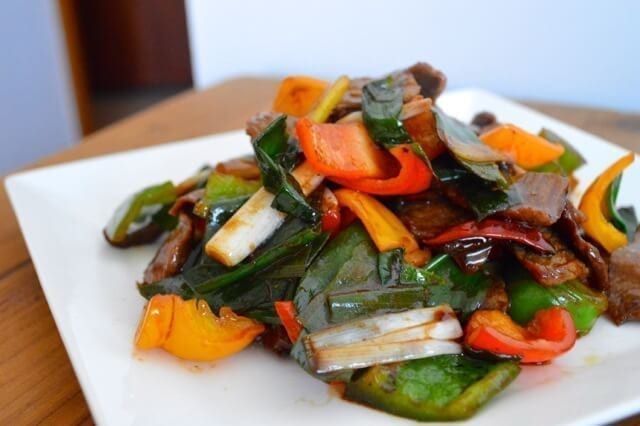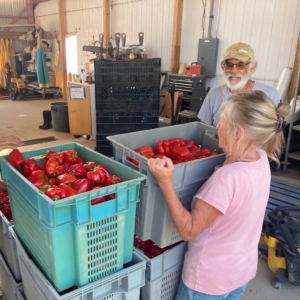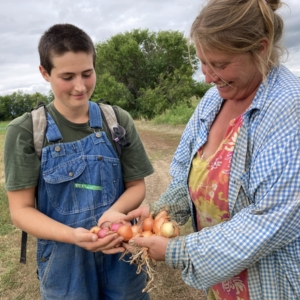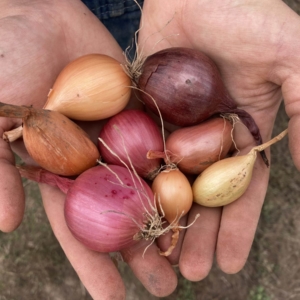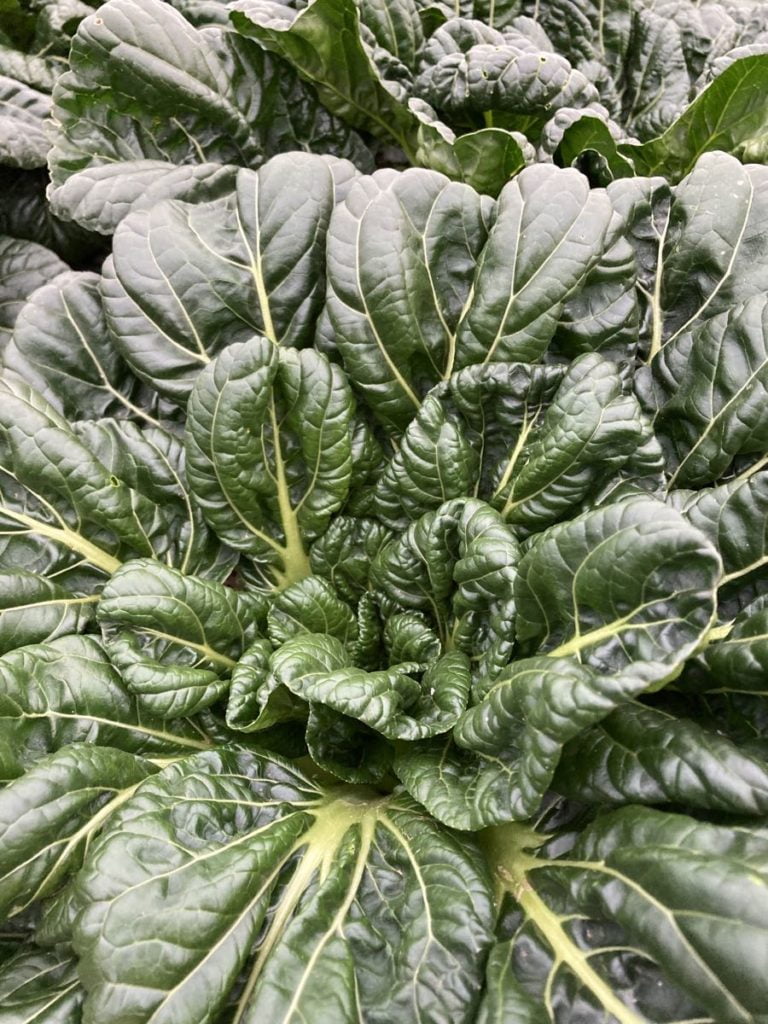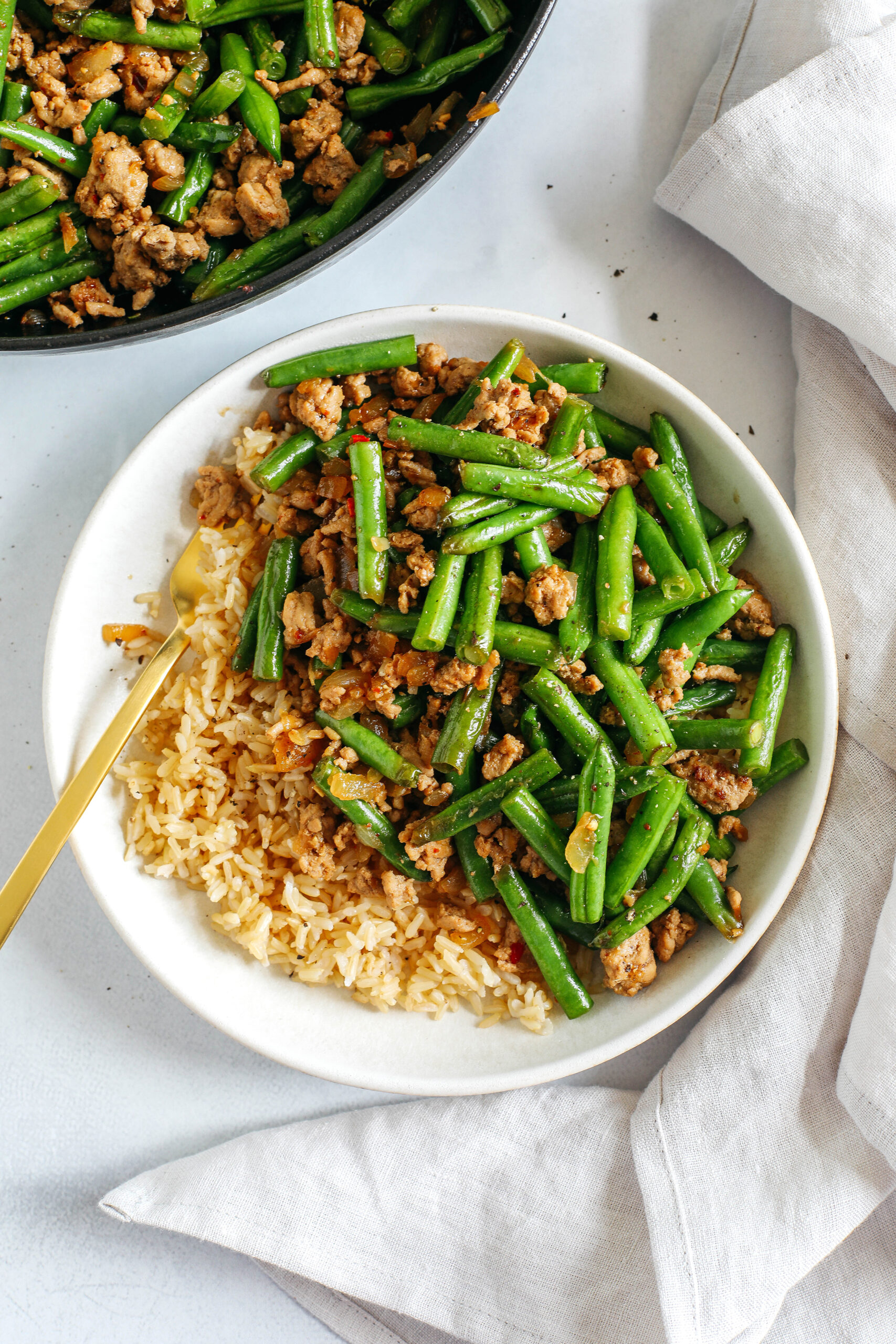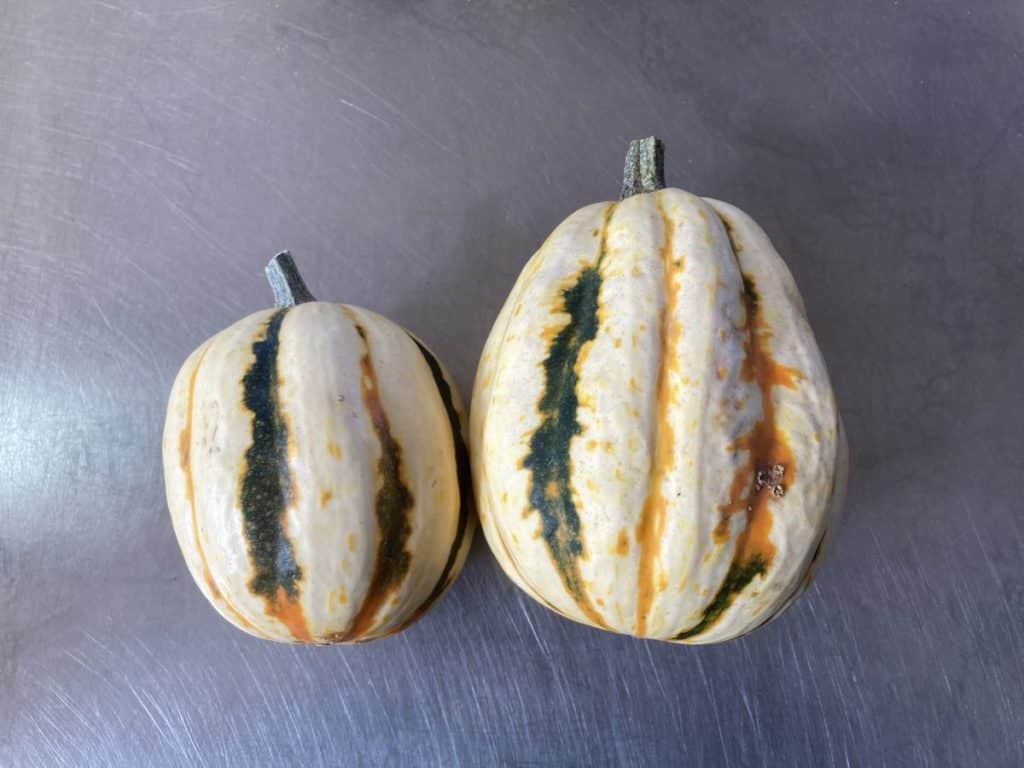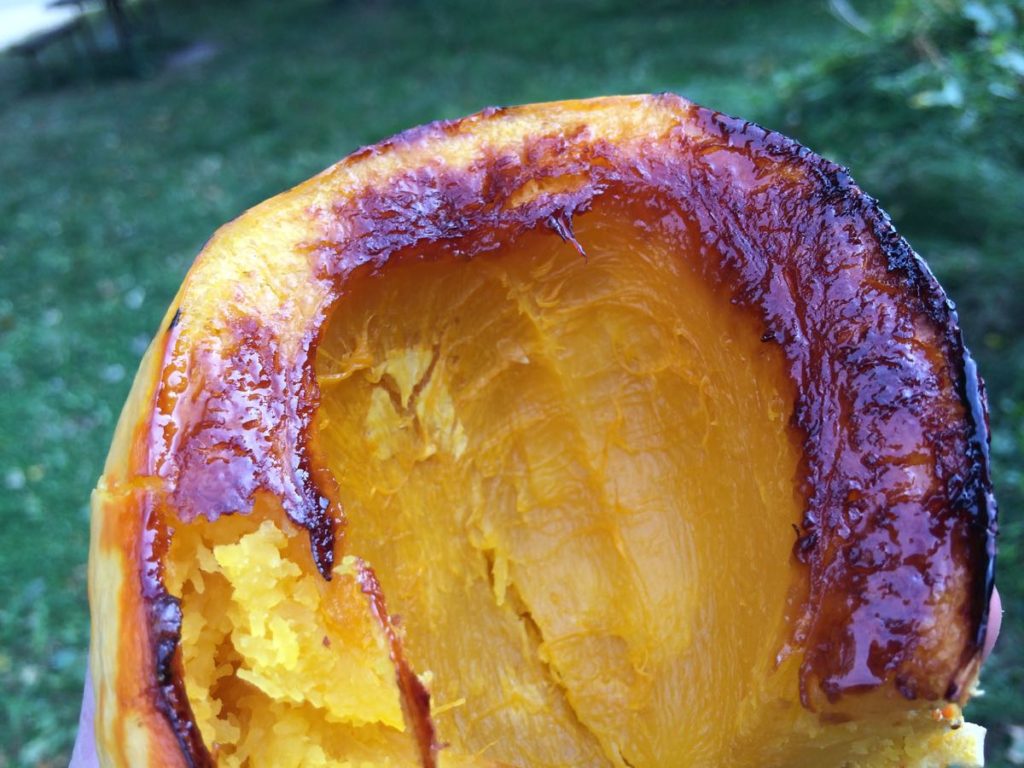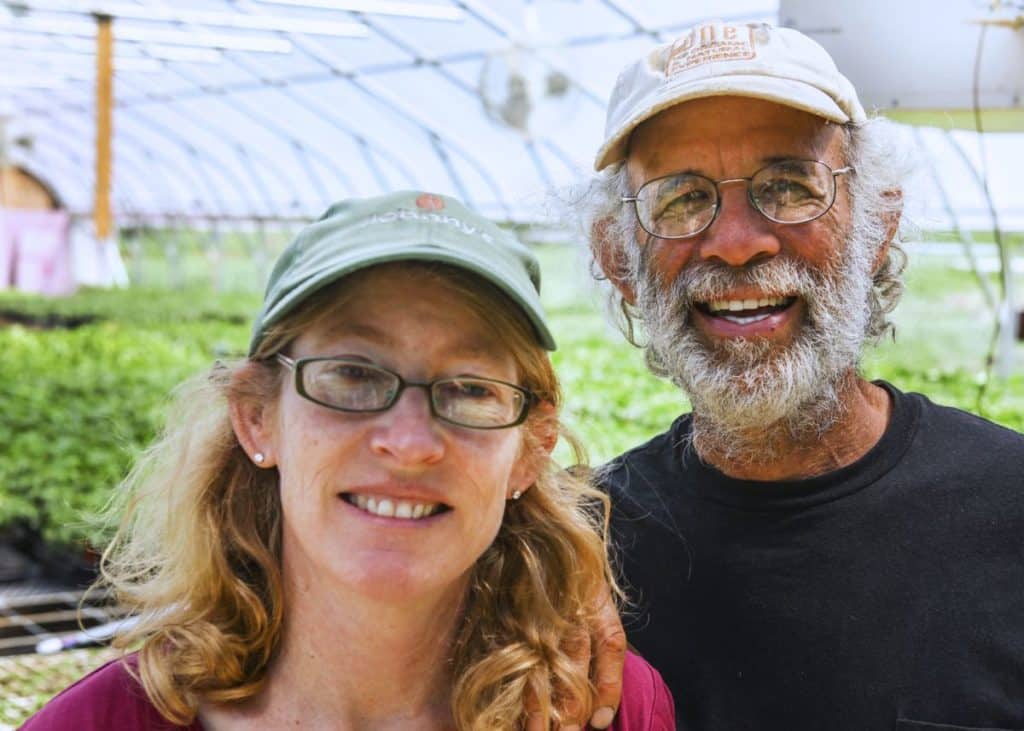Farm Newsletter
Week #22, final Sampler/B box
- On: October 11, 2023
 0
0
The gleaning party was a success! The weather was mild; chilly but dry and not too windy. The sky was beautifully quilted with clouds. Everyone found treasures to take home. The most popular gleaning crops were pumpkins, flowers, basil and kale/collards. I will tell you, those pumpkins were fully ripe in mid-August! It is a miracle that they remained solid and beautiful for almost two months. This is unprecedented.
Basil was a last-minute gleaning crop. By the weekend, we knew it would suffer cold damage on Sunday night, so I offered entire plants to take home. The farm smelled amazing!
Quite a few people hiked to the back of the farm, to explore or to glean winter squash. Steve and I both enjoyed talking with so many of you. We always learn something new when you visit.
Beth & Steve
Veggie List & Veggie Notes
Week #22, October 12/13, 2023
– Weekly shares
– BiWeekly/ green
– Sampler/ B group
Autumn Frost winter squash
Carrots, 2 lb
Poblano chilies, 2 (packed in bag of carrots)
Daikon radishes (white or purple or red)
Bok choy
Colored peppers, ~2
Yellow onion
Scallions
Garlic, 1 medium bulb
By site: purple OR white cauliflower OR smaller cauliflower plus Romaine lettuce
Next week’s box will probably contain butternut squash, red cabbage, greens and more.
‘Autumn Frost’ squash – Store cool and dry. 60 F is ideal.
This beautiful frosted squash has both pumpkin and butternut squash breeding. They cook and taste like an unusually good butternut, with rich, smooth texture. This is a fairly new variety. The breeders really knocked it out of the park with this one. The skin is edible.
Poblano chiles – Your chilies could be green or red. We packed them in the bag of carrots so they will be easy to identify.
Korean radishes – These are a favorite vegetable among our farm crew. Crunchy Korean radishes are sweeter and milder than Japanese daikon radishes and come in a more manageable size. They contain lots of water, which makes them easy to pickle or ferment. You’ll receive at least two of the colors we grow: white, red and purple.
Storage: Refrigerate.
Uses: Maangchi rules for radish ideas! Head to her website for dozens of radish recipes. She has the best website for Korean recipes. Her Radish Kimchi recipe is close to foolproof and easy to scale.
More uses: Phoebe has a recipe below for “Quick pickled vegetables” that can be made with grated carrots and daikon. It’s like the pickled slaw served on bahn mi sandwiches.
Scallions – Your scallions will need a little extra prep. I asked the crew to trim roots and wash, but not do our usual full prep, to save time on a busy day. Just pull off an outer leaf or two.
Garlic – This is German Extra Hardy variety, the type with large cloves.
Cauliflower – You’ll get purple or white cauliflower. FYI, the purple color darkens when cooked.
Storage: Refrigerate.
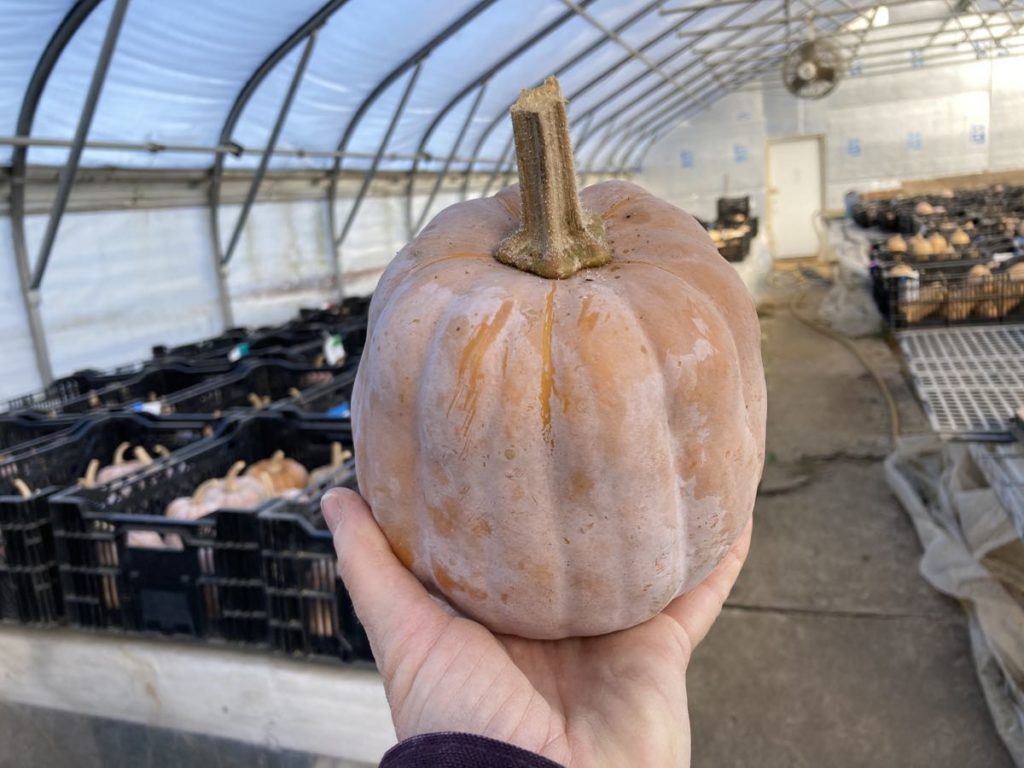
Pretty, pretty Autumn Frost winter squash.
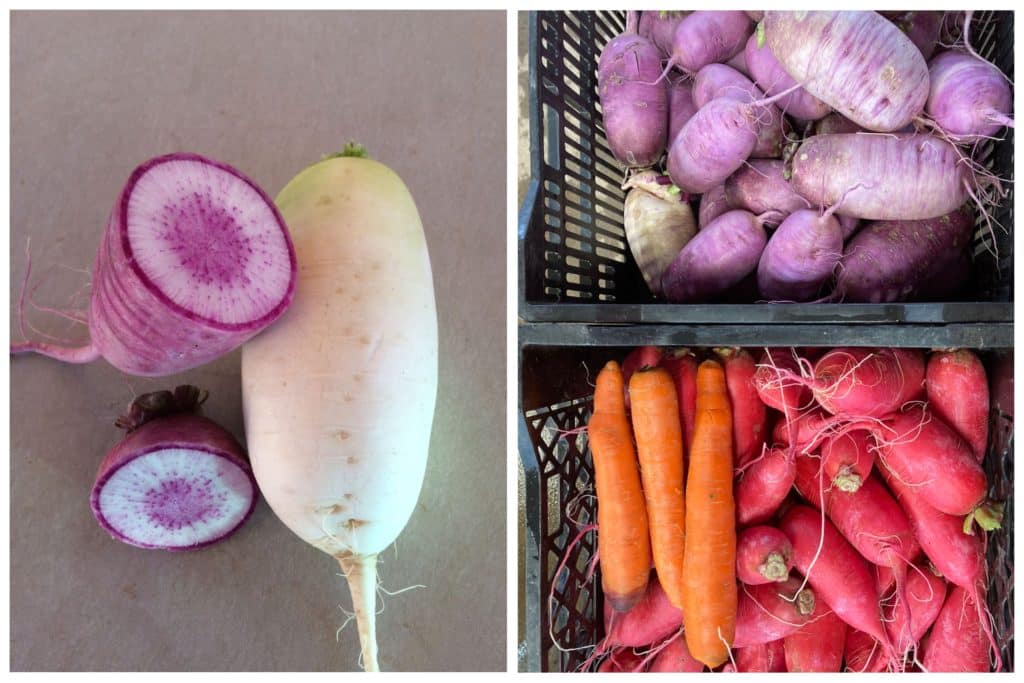
You will receive at least two of the daikon colors we grew this year; white, red and purple.
RECIPE from BETH
Steamed Coconut Custard in Autumn Frost
Thai pumpkin custard is a treat, and can be prepared in an Autumn Frost pumpkin. That’s my custard in the photo above. Autumn Frost really is that color inside! I based my version on these recipes, with alterations.
Thai Pumpkin Custard, from Cooking with Lane
Thai Pumpkin Custard, from Amporn’s Thai Kitchen
Beth’s notes.
– I’ve only made this in a steamer.
– Steam your hollow squash for 25 minutes before adding the custard mixture. Otherwise, your squash is overcooked by the time the custard is set.
– I’ve never used pandan leaves.
– The linked recipes call for coconut milk or coconut cream. I substitute a mixture of coconut milk and oat milk as I prefer it less rich. I’ll pull together my cooking notes this weekend and will share my custard mixture here and on the Facebook group page.
RECIPES by PHOEBE
Pepper Lovers’ Pizza
Love peppers on pizza? This recipe is for you! It stars colorful roasted peppers, tangy pepper jack cheese, and red pepper flakes for an extra kick of heat. You can use any of the peppers from your share here—just keep in mind that the poblanos will increase the spice level.
Serves 2 to 3
Prep time: 20 minutes
Cook time: 30 minutes
6 ounces mixed peppers (bell, frying, poblano, etc.), stemmed, seeded, and thinly sliced
¼ onion, sliced into thin wedges
Extra-virgin olive oil, for drizzling
Sea salt
2 tomatoes from a can of whole peeled San Marzano tomatoes
1 cup grated low-moisture, part-skim mozzarella cheese
1 cup grated pepper jack cheese
Cornmeal, for stretching the dough
1 pound pizza dough, store-bought or homemade*
2 garlic cloves, thinly sliced
½ teaspoon dried oregano
Red pepper flakes, for sprinkling
Preheat the oven to 425°F and line a baking sheet with parchment paper.
Place the peppers and onions on the baking sheet, drizzle with olive oil, and sprinkle with salt. Toss to coat and spread evenly on the baking sheet. Roast until soft and browned around the edges, 15 to 20 minutes. Remove from the oven and set aside. Increase the oven temperature to 500°F.
Place the whole peeled tomatoes in a medium bowl and use your hands to crush them into a slightly chunky sauce. Add ¼ teaspoon sea salt and stir to combine.
In another medium bowl, place the mozzarella and pepper jack cheeses and toss to combine.
Dust another large baking sheet or pizza pan with cornmeal. Place the pizza dough on the baking sheet and stretch it into a large circle or oval. Spread the tomatoes evenly over the dough, leaving a 1-inch border around the edges. Top with all but ¼ cup of the cheese mixture, then top with the roasted peppers, onions, garlic, and dried oregano. Sprinkle the remaining ¼ cup cheese on top.
Bake for 10 to 15 minutes, or until the cheese is bubbling and the crust is golden brown.
Remove from the oven and sprinkle with red pepper flakes. Slice and serve.
*If using store-bought dough, let it sit at room temperature for 1 hour before stretching.
Quick Pickled Vegetables
From The Modern Proper
These quick pickled carrots and daikon would be a great addition to a homemade banh mi, but the uses for them don’t end there. Pile them onto a burger or BBQ sandwich, add a scoop to a grain bowl, or top them onto cold sesame noodles.
Boiled Daikon Radish
From The Woks of Life
If you’re used to eating radishes raw, you might be surprised how much you enjoy this simple boiled daikon recipe. The cooking process mellows the radish’s bite, yielding a delicious, nourishing side dish.
Butternut Squash Mac and Cheese
From Love & Lemons
This ultra-comforting mac and cheese features a creamy sauce made from part cheese, part roasted squash. The recipe calls for butternut, but autumn frost squash would add exceptional flavor!
Maple Tahini Glazed Cauliflower with Chipotle
From The First Mess
Purple and white cauliflower are both fair game here! The smoky chipotle seasoning and sweet, nutty tahini sauce will make them irresistible.
Ginger Peanut Chicken with Coconut Rice
From Pinch of Yum
In this satisfying weeknight recipe, a gingery, peanut-y medley of chicken thighs, scallions, and bok choy tops a fragrant bed of coconut rice. Omit the cilantro if you don’t have any on hand.
Chicken Wonton Soup
From Smitten Kitchen
Homemade wonton soup is the perfect cozy cooking project for a rainy fall day! Finish the soup with chopped bok choy instead of spinach.
Week #21, Final box for Sampler/ A group
- On: October 04, 2023
 0
0
This week (October 5/6) is the final delivery for our Sampler/ A group members, unless you rescheduled to a later week.
We are in the final month of our regular-season CSA deliveries. I find this shocking but it is October. Please identify the date of your final delivery on the calendar above. Please communicate that information with everyone picking up your produce. If you don’t remember your green/purple/A/B/C/D assignment, then log into your account and view your schedule there. Instuctions are under ‘View your schedule and orders.’
FYI, I will continue to send my weekly email to all members each week, even after their deliveries end. I want you to have info on farm events, recipes and we might add an extra late-season share.
Thanks,
Beth
Veggie List & Veggie Notes
Week #21
– Weekly shares
– BiWeekly/ purple
– Sampler/ A group
Sweet potatoes, ~3 lb
Carrots, ~2 lb
Celeriac
Romano beans, ~1 lb
Jalapeno chile (packed in bag of beans so it’s easy to identify)
Kale or collards, 1 bunch
Red peppers, mixed bell and frying
Oranos snack peppers, several
Yellow onion
By site: Large cauliflower OR medium cauliflower + broccoli
Next week’s box will probably contain carrots, winter squash, peppers, fall greens and more.
‘Orleans’ sweet potatoes – Store your sweet potatoes at room temperature. They suffer chilling injury below 50 F.
Here are a few things we’ve learned about sweet potatoes:
– For best flavor, cook your sweet potatoes so they brown and caramelize. We have a simple, favorite way to roast sweet potatoes. We used to prepare sweet potato fries in the oven. Now we just quarter the potatoes, rub with olive oil, dust with salt and place cut-side-down on a cookie sheet. Roast in a 450 F oven without turning until soft. The flavors will caramelize (like sweet potato fries) but preparation is simpler and the cooking time less exacting. Slender sweet potato fries go from undercooked to overcooked in the blink of an eye. Larger slices are less exacting, and therefore are easier. Small sweet potatoes can be cut just in half. Jumbos will need to be chopped into pieces. Otherwise, they take a long time to cook.
– This first batch of sweet potatoes will need slightly longer cooking than ones from the supermarket. I think this is because they contain higher moisture so soon after harvest.
– Sweet potatoes are good at any size. We have cooked everything from tiny to jumbo and consistently find that all sizes taste good.
Carrots – These are from our first harvest of fall carrots. Storage: Refrigerate.
Romano beans – Romano beans are more robust and meaty than green beans. They are excellent raw but really shine when braised (gently cooked for a long time).
Oranos snack peppers – We have a wonderful abundance of Oranos this year! They are a fabulous little package, crisp, jewel-toned, with very few seeds. They are great to pack in lunches or use for dips.
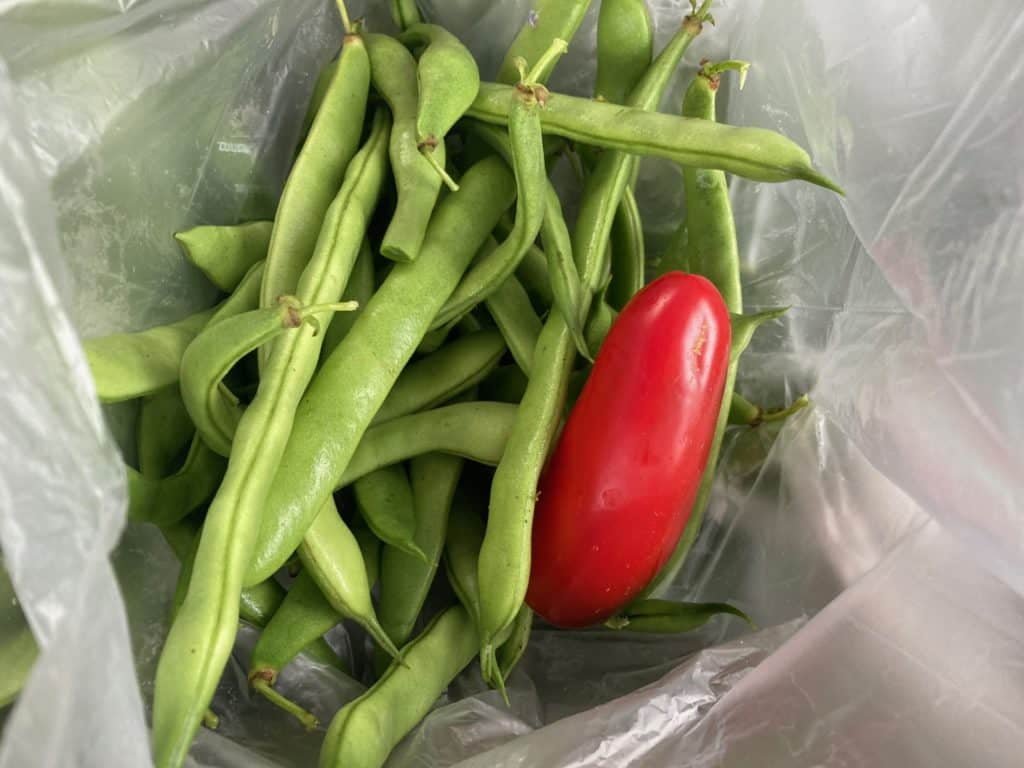
Your jalapeño is packed in your bag of beans so it is easy to identify. Your jalapeño could be red or green.
RECIPES by DEB
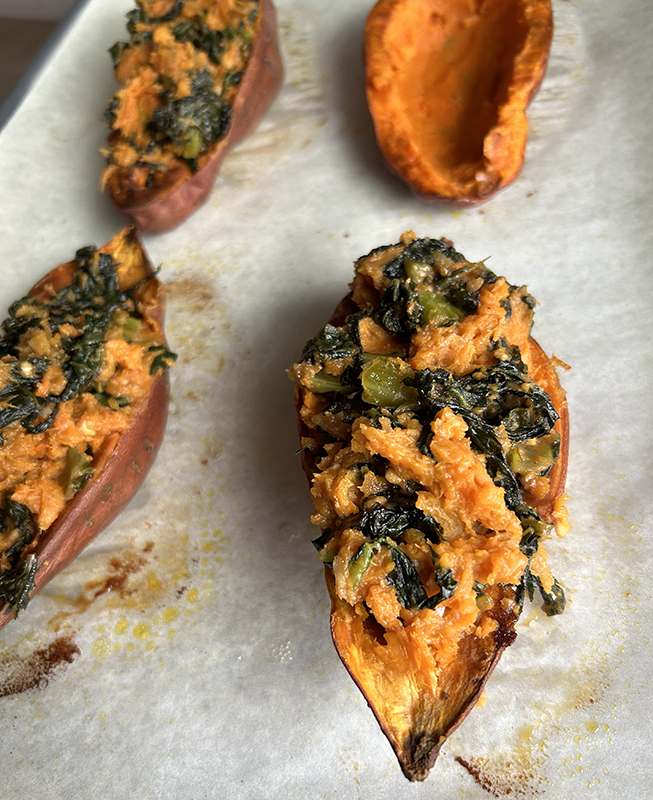
Sweet Potatoes Stuffed with Greens & Peanut Sauce
Serves: 4 as a side; 2 as a main course
Takes: 40 minutes to an hour to roast the potatoes; about 20 minutes active time to make the filling & stuff
The basic technique in this recipe can be varied many ways; try black beans with salsa and cheese, or swap tahini or almond butter for the peanut butter. It’s not strictly necessary to scoop out the potato and stuff it back into the shell with the filling ingredients. You can simply pile the filling on top of the potato halves and serve. The stuffed sweet potatoes reheat beautifully in the microwave (or oven) and you can also roast the potatoes and refrigerate for later stuffing and eating. I tested this recipe with Koji greens (minus the stems) because that’s what I had, but just about any green will work, such as kale or collards. If using a softer green like spinach use 1 pound instead of 8 ounces.
Potatoes:
2 large sweet potatoes, about 1 3/4 to 2 pounds
1 tablespoon vegetable oil
Filling:
1/2 pound greens, such as kale or collards, washed, large stems removed, and thinly sliced
2 tablespoons vegetable oil
kosher salt
2 large cloves of garlic, minced or put through a press
2 tablespoons fresh ginger, grated
1-2 tablespoons soy sauce or tamari
1 tablespoon brown sugar or honey or maple syrup
1 tablespoon rice vinegar
1 tablespoon Sriracha or other hot sauce, optional
1/4 – 1/3 cup natural peanut butter, smooth or crunchy (I like crunchy!)
Extra hot sauce and chopped peanuts for serving
- Roast the potatoes: heat the oven to 350°. Scrub the potatoes and cut in half lengthwise. Arrange on a parchment lined baking sheet and drizzle with the oil. Turn the potatoes cut sides down and place in the oven and roast for 40 minutes to an hour until soft. Remove from the oven and cool until easy to handle.
- Make the filling: Pour 2 tablespoons vegetable oil into a wide deep skillet with a lid. Heat over medium high heat. Add the greens and a few pinches of salt, stir to coat with oil, and cover and cook to wilt the greens, 5-10 minutes.
- Reduce the heat and uncover the skillet and add the garlic, ginger, soy sauce, brown sugar, and rice vinegar. Stir and then add 1/4 cup peanut butter. Cover the pan over the lower heat for few minutes to melt the peanut butter. Stir and if it doesn’t seem saucy enough to you, add more peanut butter.
- Stuff the potatoes: Scoop out the centers of the sweet potatoes and mash into the greens and sauce. Spoon the filling back into the potato shells. Set the potatoes back in the oven for about 15 minutes to reheat and serve with optional hot sauce and peanuts. Alternatively cool the potatoes and reheat in the microwave (or oven) to eat later.
Cauliflower Coronation Salad
From DebsLunch
This is a vegetarian version of Coronation Salad, a curried chicken salad that was the official dish for Queen Elizabeth II’s coronation in 1954. The chicken version is often served as a tea sandwich filling on buttered white bread; try this vegetarian version in pita or on a bed of greens. I think it would also be good on any type of sandwich roll. You could make this vegan by using egg-free mayo, and non-dairy yogurt in the dressing.
.
.
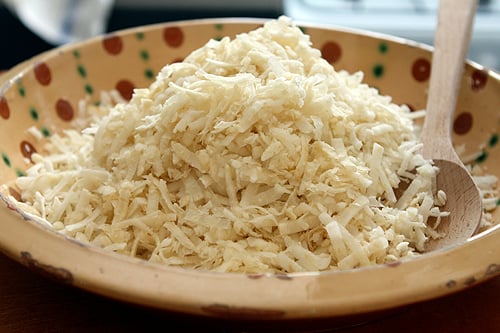
Celery Root Remoulade (Celeri Remoulade) | David Lebovitz
From David Lebovitz
Here’s a French version of Celeriac Remoulade, or celery root slaw, from cookbook author David Lebovitz. Although it may be cooling off soon, the October weather so far has been a bit too warm for some of the other heartier preparations of celeriac, gratins or soups. Lebovitz discusses grating the celeriac into thick-ish shreds with a Moulinex grater so it keeps its crunch, but this type of grater is not widely availble in the U.S. A box grater will work; probably even better is to hand cut the celeriac into julienne with a good sharp knife. Peel the celeriac (Lebovitz provides illustrations), slice into thin rounds, and then slice the rounds into thin strips.
.
.

Romano Beans with Shallots and Bacon | Pinch and Swirl
From Pinch and Swirl
Romano beans are often braised with tomatoes (fresh or canned) and onions – Smitten Kitchen has a good recipe if you’d like to prepare yours that way. This recipe from Pinch and Swirl is a quicker saute with shallots and bacon. Subbing a similar amount of regular onions for the shallots will work just fine!
.
.
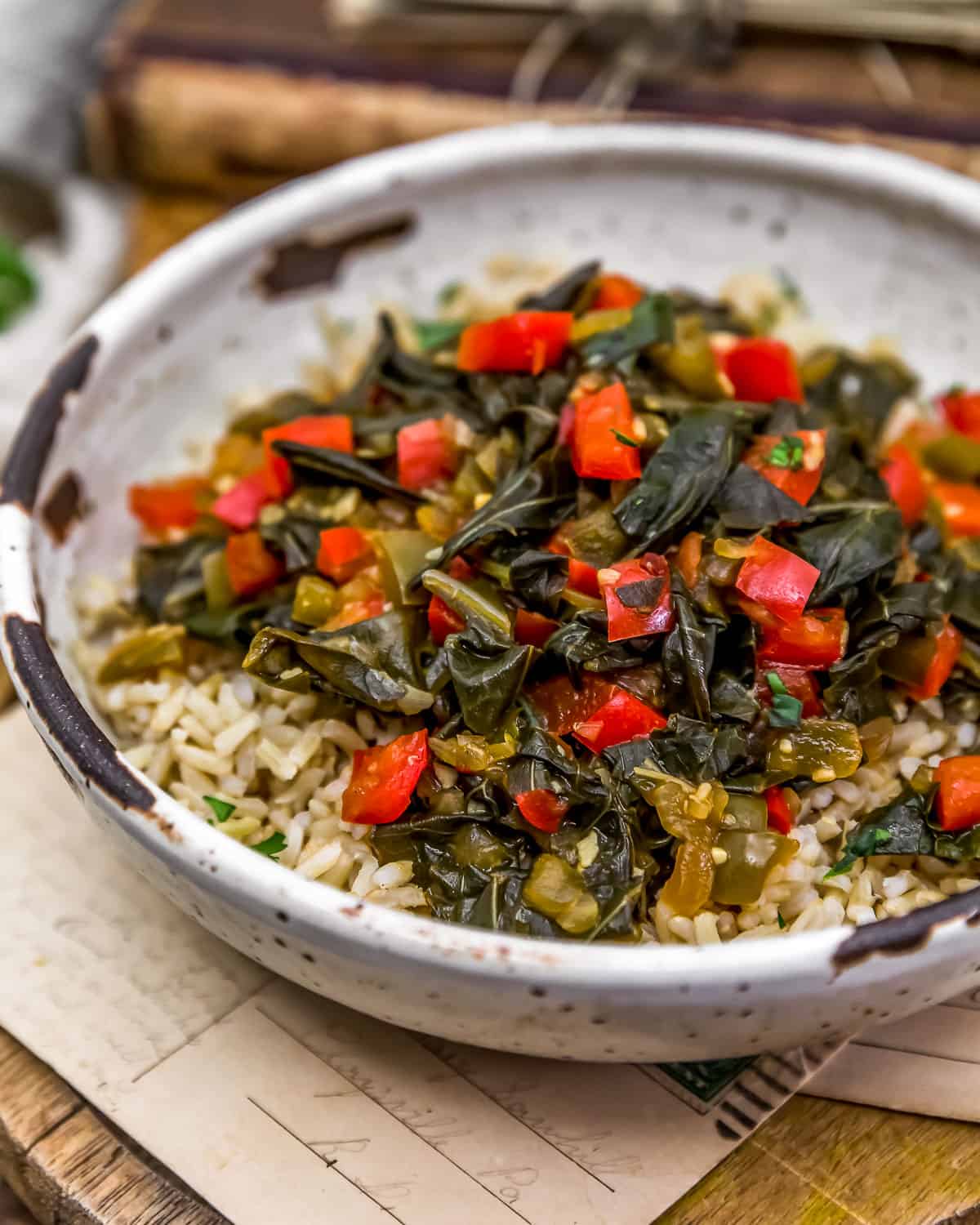
Sweet and Spicy Collard Greens | Monkey and Me Kitchen Adventures
From Monkey and Me Kitchen Adventures
This recipe combines the collards and sweet and hot peppers and onions from this week’s box in a stir fry served over rice. Sauce ingredients include a number of dried spices, like garlic powder and onion powder, that you can omit in favor of fresh.
.
.

Vegetarian Sweet Potato Chili | Cookie and Kate
From Cookie and Kate
Along with sweet potatoes and peppers that we get in this week’s box, this vegetarian chili recipe use black beans and kidney beans, either canned or cooked from dried. A nice substitution for one of the types of beans would be our Romano beans, cut into 1-2 inch lengths. You might even want to try some of the celeriac, cut into cubes and added with the onions, for a nice celery flavor in your chili.
.
.
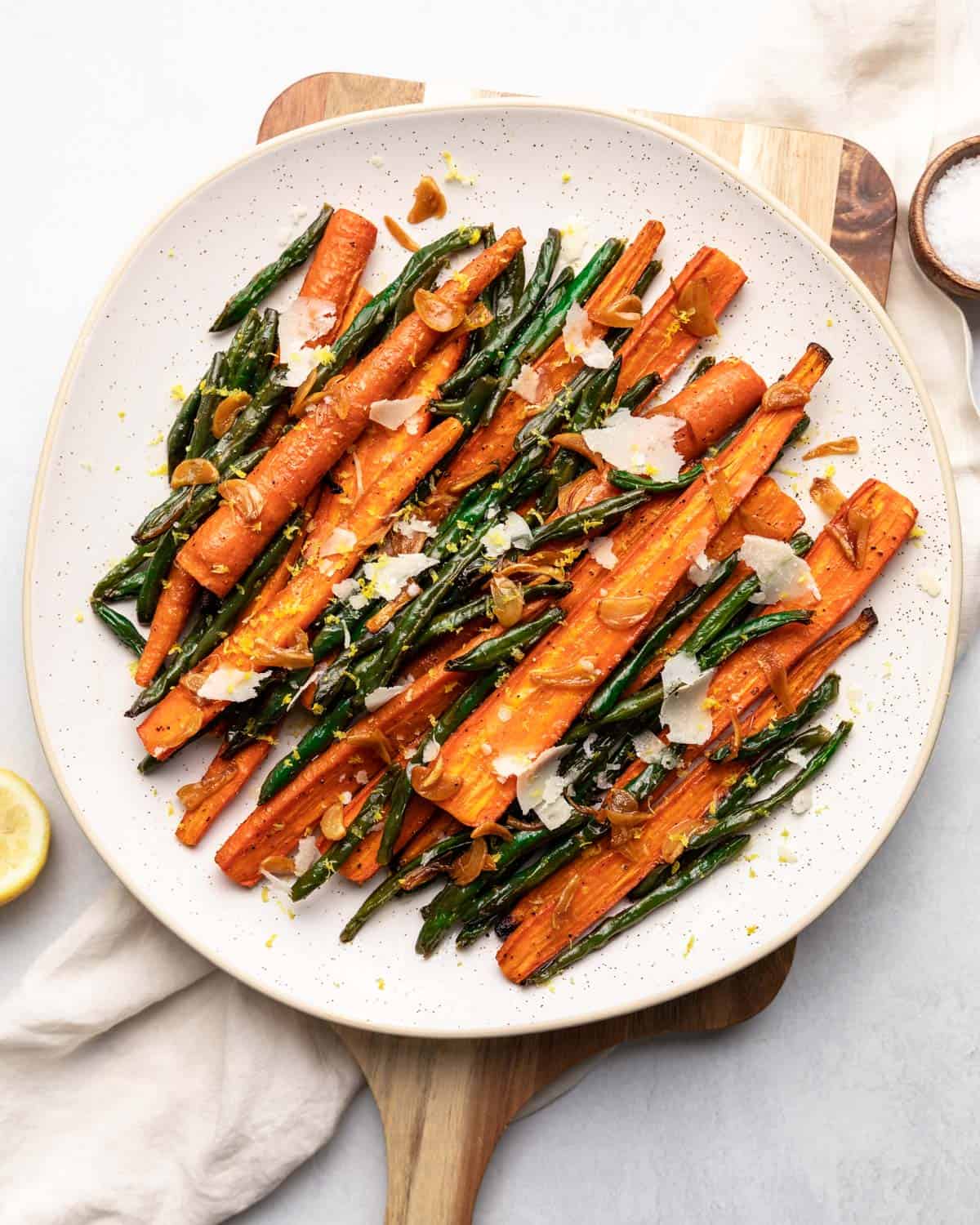
Roasted Green Beans and Carrots | Bites with Bri
From Bites with Bri
Originally written for regular green beans, the Romano beans in our box can sub in perfectly here, in this recipe that combines green beans and carrots roasted with a bit of honey and finished with a butter-garlic-lemon sauce and Parmesan cheese.
Week #20; Who grows your food? Part 2.
- On: September 27, 2023
 0
0

Sweet potato harvest with the H-2A crew.
I wrote last week to honor our hard-working farm crew. This week, let’s acknowledge another group who works for us a few days each year. Since 2015, we have hired a migrant labor crew to weed carrots and do other big jobs. Labor contractor (team leader) Carlos Aguilera brings 35 people to our farm for four or five days. All are temporary agricultural workers from Mexico or Central America, working in the US under the H-2A program for agriculture.
Many of you buy our carrots and other produce at Willy Street Coop through the winter. Without their labor, we could not grow these winter crops. We plant carrots on a tight schedule in July so they are ready to harvest in fall. That puts us on a tight weeding schedule too. Our regular crew does not have time to weed these big fields; they already have a full workload. So we bring in Carlos’ crew.
Thirty-five guys show up in a colorful school bus, spread out in our fields and leave them clean of weeds a few hours later. We have a short list of jobs for them. This year, they weeded carrots and beets, harvested green beans, onions and sweet potatoes, and helped us clean up finished fields. They accomplished all that in just four six-hour days. They are professional farmhands with high standards for their work.
Carlos’ primary contracts are with seed producers in the area. (He must have a signed contract at each business where they work.) We are their smallest contract, offering just a few days per season, so we have to work with whichever days they are available, usually on weekends.
US Immigration showed up at our farm for a surprise inspection this year. Remember the August day when temps hit 99 degrees? Two immigration agents walked into our work shed, asking to see paperwork for the H-2A crew. We had it but our employees were arriving at the same time so it was a scramble. That day, agents visited each farm where Carlos’ team works. I am reassured to know they do that, that they are watching out for the welfare of these workers. Carlos told me the agents visited the farm where they were stationed that day, to check working conditions and that workers have access to their own passport. That’s important, as abusive labor contractors could hold their workers’ passports. That’s illegal.
Carlos Aguilera is well-organized and seems to take good care of his team. Over the years I’ve had our Spanish-speaking employees work side-by-side with the H-2A crew. I learned that they spend 90% of their time making fun of us and the rest teasing Carlos.
What is their favorite vegetable? We send them off with lots of melons and sweet corn, their favorites among what we grow. They are most excited for the corn, telling us they roast it and eat it sprinkled with cheese, salt and chile peppers.
Thanks for reading.
Beth and Steve
Veggie List & Veggie Notes
Week #20, September 28/29, 2023
– Weekly shares
– BiWeekly/ green
– Sampler/ D group
Green cabbage
Cauliflower, 1 head
Broccoli, 1 head
Leek, 1 or 2
Acorn squash, 2, ‘Starry Night’ or ‘Jester’ or ‘Carnival’
Green beans, ~1 lb
Frying peppers, ~4 ct
Oranos snack peppers, several
Jalapeno chile, 1
Garlic, 1 head
Next week’s box will probably contain cauliflower, winter squash, peppers and more.
Cauliflower and broccoli – Storage: Refrigerate.
Leeks (look like big scallions) – These alliums have a milder flavor than onions. Nonetheless, they can be used in recipes that call for onions. To wash, split the leek lengthwise, from the green tops about halfway to the base, leaving the base intact. Rinse well under running water, separating the layers to flush. If necessary, split the leek further if soil has penetrated more than halfway down the leek. Shake dry. Leeks are generally eaten cooked. They can be sauteed, steamed or roasted. Intact leeks will store 2 to 3 weeks if covered loosely and refrigerated. The outer leaves will yellow. Just peel off and discard those yellow leaves. The inner layers will be fine.
Winter squash – Store at room temperature.
Oranos snack peppers (sweet, orange) – Everyone gets a handful of Oranos snack peppers. These are sweet and wonderful for snacking, loaded with flavor but sparse seeds.
Jalapeno chile – These are small, green and shiny. Some have a red tip. These are the only hot pepper in the box.
Garlic – This is the German Extra Hardy variety, with large cloves. FYI, some heads look odd because they dried slower than I would have liked.
RECIPES by PHOEBE
Winter Squash & Pecan Pâté
Don’t let the name pâté put you off—this savory squash dip is made with 100% plants! It’s creamy, nutty, and tangy, with a subtle sweetness from the squash and roasted alliums. Served with crackers or crostini, it would be a lovely appetizer for a fall gathering.
Prep time: 15 minutes
Cook time: 45 minutes
Serves 8
1 cup raw pecan halves
1 acorn squash
½ medium onion, cut into 4 wedges
4 garlic cloves, unpeeled
¼ cup extra-virgin olive oil, plus more for drizzling
2 tablespoons apple cider vinegar
1 teaspoon dried thyme
1 teaspoon ground cumin
¾ teaspoon sea salt, plus more for sprinkling
2 tablespoons water, plus more as needed
Freshly ground black pepper
Pepitas, for garnish (optional)
Crackers and/or baguette, for serving
Preheat the oven to 375°F and line a baking sheet with parchment paper.
Spread the pecans evenly on the baking sheet and place in the preheating oven. Toast until fragrant, 5 to 8 minutes, while the oven preheats. Transfer to a bowl and set aside.
Slice the squash in half vertically and scoop out the seeds. Rub the squash halves with a drizzle of olive oil and sprinkle with salt and pepper. Place cut side down on the baking sheet and add the onion wedges. Drizzle the onions with olive oil and sprinkle with salt. Place the garlic cloves in a small piece of foil and drizzle with olive oil. Wrap tightly and place on the baking sheet.
Roast the vegetables for 20 to 25 minutes, or until the onions are browned and soft. Remove the onions from the baking sheet and continue roasting the squash and garlic until the squash is soft and easily pierced with a fork, another 10 to 20 minutes. Remove from the oven and allow to cool slightly, then peel the garlic cloves and measure 2 cups of the roasted squash flesh.
Place the pecans in a food processor and process until finely ground. Add the 2 cups squash, the roasted garlic, onions, olive oil, apple cider vinegar, thyme, cumin, salt, and 2 tablespoons water. Process until smooth, adding more water as needed to form a smooth, creamy spread. You may need up to 6 tablespoons total depending on the moisture content of your squash. Season to taste.
Transfer the pâté to a serving dish. Top with a drizzle of olive oil and pepitas, if using, and serve with crackers or baguette.
Tri-Color Pepper Steak with Leeks
From The Woks of Life
Many Chinese pepper steak recipes call for onions, but this twist by The Woks of Life features leeks instead…dark green tops included! If you don’t keep Shaoxing wine on hand, replace it with dry cooking sherry or stock.
.
.
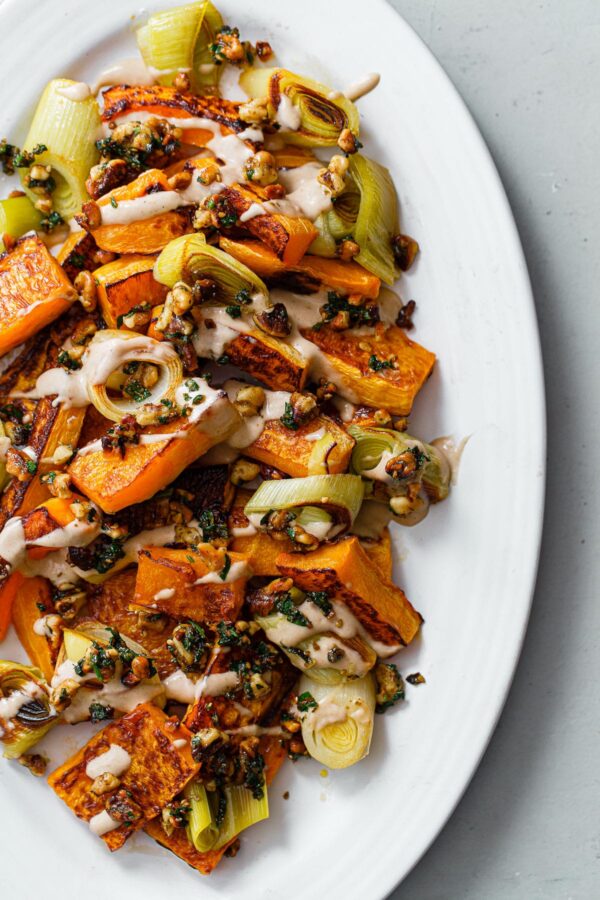
Photo by A Beautiful Plate
Roasted Squash and Leeks with Orange Tahini Sauce, Walnuts, and Za’atar
From A Beautiful Plate
This recipe highlights one of my favorite ways to cook leeks: by simply roasting them! They add lovely savory flavor to this stunning fall side dish, which features creamy roasted squash, a citrusy tahini sauce, and walnuts for crunch.
Acorn squash will work well here in place of the butternut, though I recommend roasting the squash in wedges with the skin on instead of attempting to peel it. If you don’t have fresh parsley, omit it, and season the roasted vegetables with an extra pinch of za’atar.
.
.
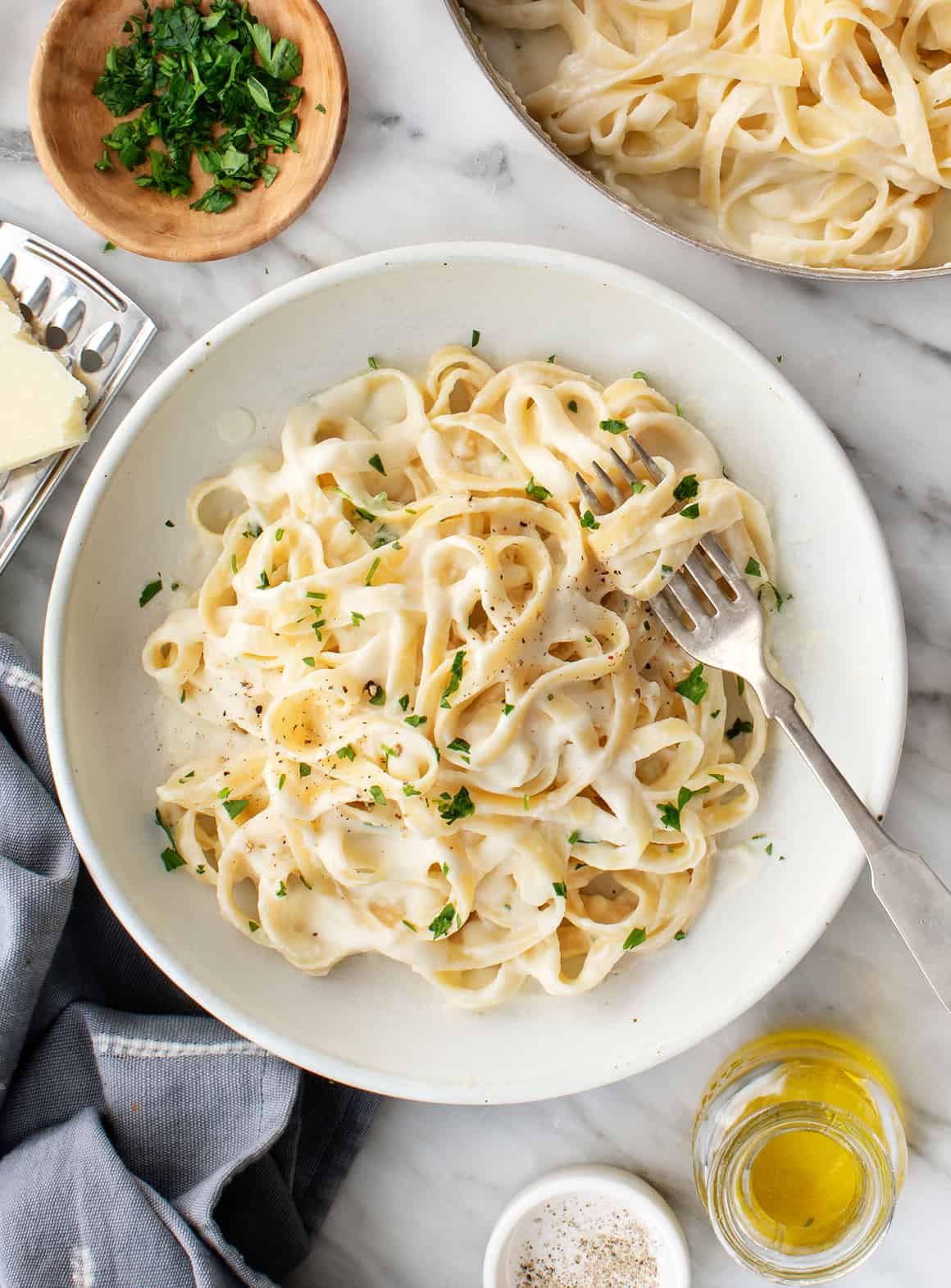
Photo by Jeanine Donofrio and Jack Mathews
Fettuccine Alfredo
From Love & Lemons
This homemade fettuccine Alfredo is creamy and comforting, but it isn’t made with any cream. Instead, boiled and blended cauliflower creates the sauce’s luscious texture. I promise you can’t taste it!
.
.

Photo by Smitten Kitchen
Crispy Cabbage and Cauliflower Salad
From Smitten Kitchen
This humble salad consists of nothing more than roasted cabbage and cauliflower tossed in a creamy tahini dressing. It’s simple and satisfying, full of caramelized flavor. Serve it with a dollop of harissa alongside to add a kick of heat.
.
.
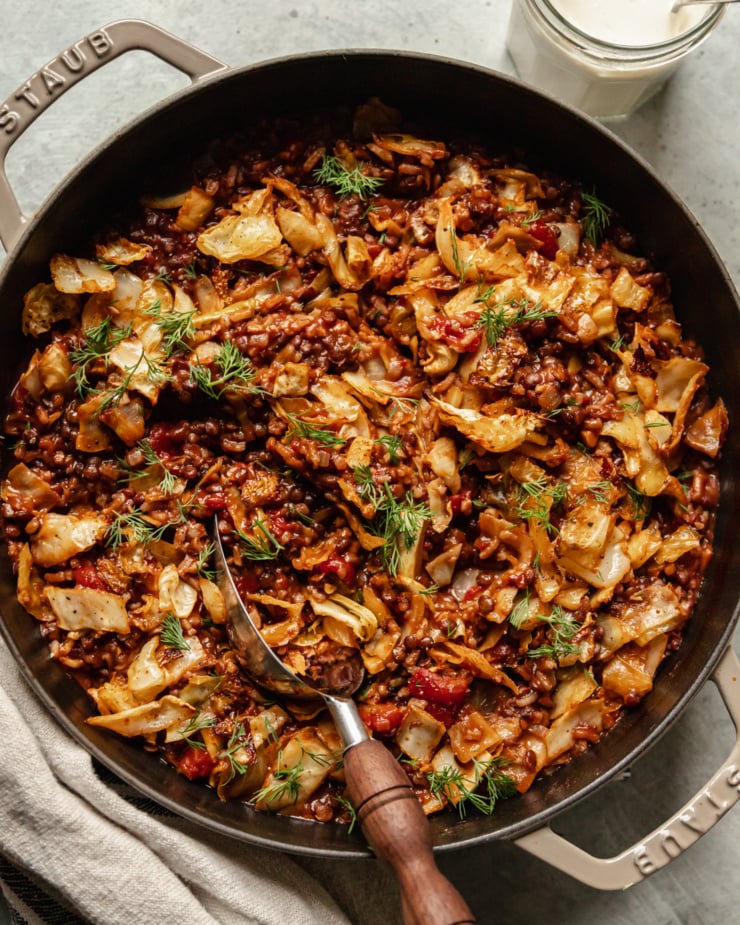
Photo by The First Mess
Vegan Chopped Cabbage Roll Skillet
From The First Mess
This hearty skillet meal is two steps away from traditional cabbage rolls. For one, it’s plant-based, made with lentils and walnuts instead of meat. Second, instead of stuffing individual cabbage leaves with the lentil mixture, you chop and roast the cabbage. Then, just before serving, you stir it into the saucy lentils. As a result, this recipe is much simpler to make than the classic dish, though it’s every bit as delicious.
Tip: It calls for a yellow onion, but leeks would be great here too!
.
.

Photo by Eva Kolenko
Sautéed Green Beans
From Love & Lemons
A lemon-Dijon dressing brightens up these quick sautéed green beans. If you don’t have fresh thyme on hand, replace it with 1 teaspoon dried, or omit it.
Week #19; Who grows your food? Part 1.
- On: September 20, 2023
 0
0
Photo captions:
– The first photo shows most new employees who joined us in spring. They bonded quickly and became great friends! From left, Katie, Aly, Mary Anne, Lizzy and Ida.
– Steve and Simone look over an amazing pepper harvest.
– We all enjoyed the day that John (right) decided to impersonate Ben (left). John shaved his head, trimmed his beard a bit and wore a blue shirt with cutoff sleeves. What a hoot. It’s a fairly easy impersonation because Ben wears the same outfit every day. He has a closet full of those shirts.
– This is a close-up of Charlotte’s favorite vegetable Romanesco cauliflower. That’s her in the background, in the orange rain pants.
– Mary Ann and Maggie both love tiny vegetables. Honestly, Maggie is obsessed. Here, they admire their gleaned tiny onions. We walked through the harvested onion field and the little ones were irresistible.
– Their tiny onions.
– Bekah harvests basil from a beautiful planting.
– Maggie and daughter Ida who joined the farm crew this season.
I am overdue to introduce you to our hard-working farm crew.
We are joined in our farming endeavor by many employees. Some have worked for us for many years. Others joined the farm this season. We rely on each of them.
Do you have a favorite vegetable? So do we. Think about our hardworking field crew when you enjoy one of their favorites. Here are our workers, the year they started working for us, and their favorite fruit or vegetable.
Ava Ahnen (2022) .
Bailey Boudreau (2023) .
Raul Casique Montes (2017) “Hot peppers because I like adding them to everything I cook.” Raul runs his own vegetable farm and makes amazing hot sauce from home grown chilis.
Katie Eastman (2023) “Peppers, because they are fresh, crisp and sweet. I eat them like an apple and have always done that.”
Mary Ann Eastman (2023) .
Aly Fry (2023) .
Charlotte Hammond (2016 – 2018, returned in 2021) “Romanesco cauliflower because it looks crazy and is delicious. I actually planted some in my home garden just in case. Some years we don’t get much here at the farm and I need it. Sometimes I look up Romanesco photos online just to stare at it.”
Pete Hartman (2023) Pizza.
Ken Kelly (worked for us many years, then returned in 2021) “That depends on the time of year. Watermelons for sure. During watermelon season, I’ll do a melon fast for a few days. Keeps you hydrated!
Me: “Do you eat the seeds?”
Ken: “Absolutely!”
Vern Mahlkuch (2014, 2020 – 2023) .
Lizzy Neuenschwander (2023) .
Karen Nicholson (2013) Winter squash, because they signify the change of seasons. She appreciates the switch to cooking fall comfort foods that comes with winter squash. Most of all, she loves the ethereal light during fall squash harvests. By that time of year, we are racing the light during harvest but she loves the elongated shadows and finds the gold and silver colors poignant.
Simone O’Donahue (1999) Simone loves peppers. She appreciates the variety of colors. A favorite job is re-potting the young plants in the warm, sunny greenhouse. She appreciates times when peppers are prolific, and has an affinity for this crop that grows well in hot summer weather. Disclaimer; Simone runs our pepper harvest crop. It’s a natural match. She also loves poblano chiles for their acoustics. They make the best rattling sound when you shake the plant or when you drop them in the basket.
Ida Schley (2023) . I forgot to ask Ida before she left for school but I can tell you she looked very happy during watermelon harvests!
Maggie Schley (1999?) Maggie loves carrots and watermelons best. Tipi carrots are a big part of Maggie’s life. They were pictured on her wedding invitation. She has lots of carrot jewelry. Everyone on the farm saves ‘lover carrots’ for Maggie; carrots that have grown together in a spiral. Maggie is always on the carrot harvest crew. Melon harvests are special because they give a chance to spend time with Steve, plus a chance to throw around a lot of weight.
Bekah Severson (2022) “My favorite vegetables are peppers because they’re fun to harvest and delicious any way you eat them!”
Ben Thomas (2019) “My favorite is poblano chiles for fabulous flavor. Tomatoes too because you can do anything with them.” I know that Ben loves winter squash because he enthusiastically takes home all the specially-chosen squash that I offer him, even as everyone else has started to back away. “But these are special ones!” does not sway anyone but Ben.
Carrot Weinstein (2022) “My favorite vegetable is the red cabbage. SO much fun to harvest, great color, lasts forever, so good fresh in a salad, pickled and fermented, roasted and charred. I love cabbage right now :)”
John Zydowicz (2019) . John loves peppers because they are crunchy and delicious, and appreciates that they come in so many diverse varieties. He likes chilis with heat and grows many types in his home garden. “It’s fun to start them in early spring and have something growing indoors.”
Steve Pincus (1975) Onions and carrots.
Beth Kazmar (1999) Asparagus. Ask me in August and I’ll say red peppers. But winter squash is my fall favorite. I eat it for breakfast every day this time of year.
Sophie (since birth, no longer farming with us) “Sweet potatoes and strawberries because they taste so good.”
Ari (since birth) Cucumbers. “You can do lots of things with them. Eat them raw or make pickles or turn them into cucumber salad.”
Veggie List & Veggie Notes
Week #19, Sept 21/22, 2023
– Weekly shares
– BiWeekly/ purple
– Sampler/ C group
Green beans, ~1 lb
Acorn squash, 2, ‘Jester’ or ‘Carnival’ or ‘Heart of Gold’
Koji greens, 1 head
Romaine lettuce
Tomatoes, a small bag
Colorful bell peppers, ~3
Oranos snack peppers, 4 or 5
Poblano chiles, 2
Yellow onion
German Extra Hardy garlic
Basil
Next week’s box will probably contain cabbage, broccoli &/or cauliflower, green beans, peppers, winter squash and more.
Acorn squash – If you haven’t yet, please read my Winter Squash Primer in last week’s newsletter.
Storage: This week’s acorn squash is best eaten within two weeks. They are excellent right now, but do not store long. And I will send more squash next week!
Koji greens (head of dark green leaves) – Refrigerate.
Koji greens are a lot like tatsoi if you know that one; dark green with a nice balance of bitter flavor but not too strong. I prefer Koji to tatsoi because it has larger, lusher leaves and not so many leaf stalks. Recipes that use mustard greens or bok choy will work with Koji. In a contest for my favorite fall green, Koji runs neck and neck with bok choy.
Tomatoes – Eat soon or refrigerate. It is fall. The tomatoes still taste amazing but will not store long.
Poblano chiles (dark green, triangular, and shiny; MILDLY HOT) – Poblanos are the creme de la creme of chiles. They have lots of great flavor in combination with manageable heat. Roast and add to soup or casseroles. To reduce heat, remove the seeds and midveins.
Yellow onions – These are pungent cooking onions. Store at room temperature.
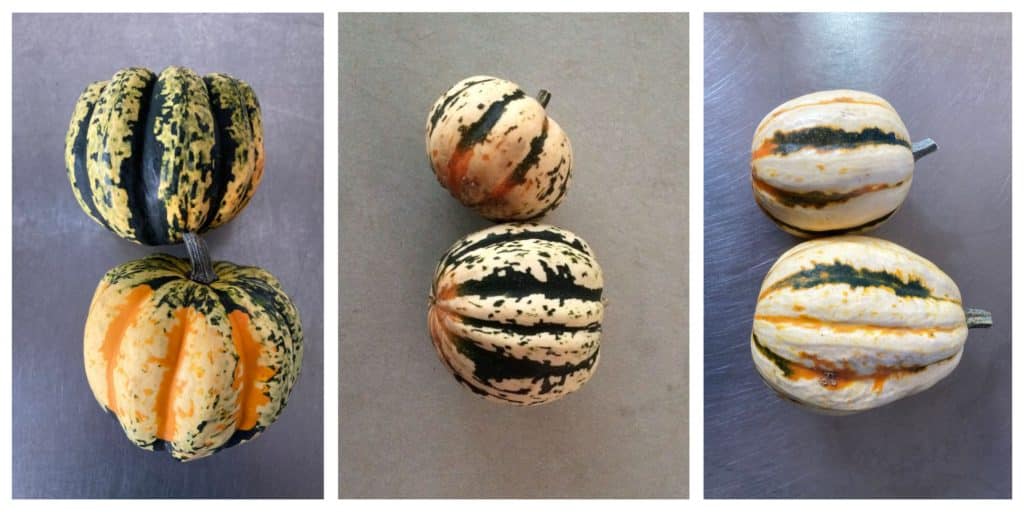
Everyone gets two squash, either ‘Carnival’ (left), ‘Heart of Gold’ (middle) or ‘Jester’ (right).
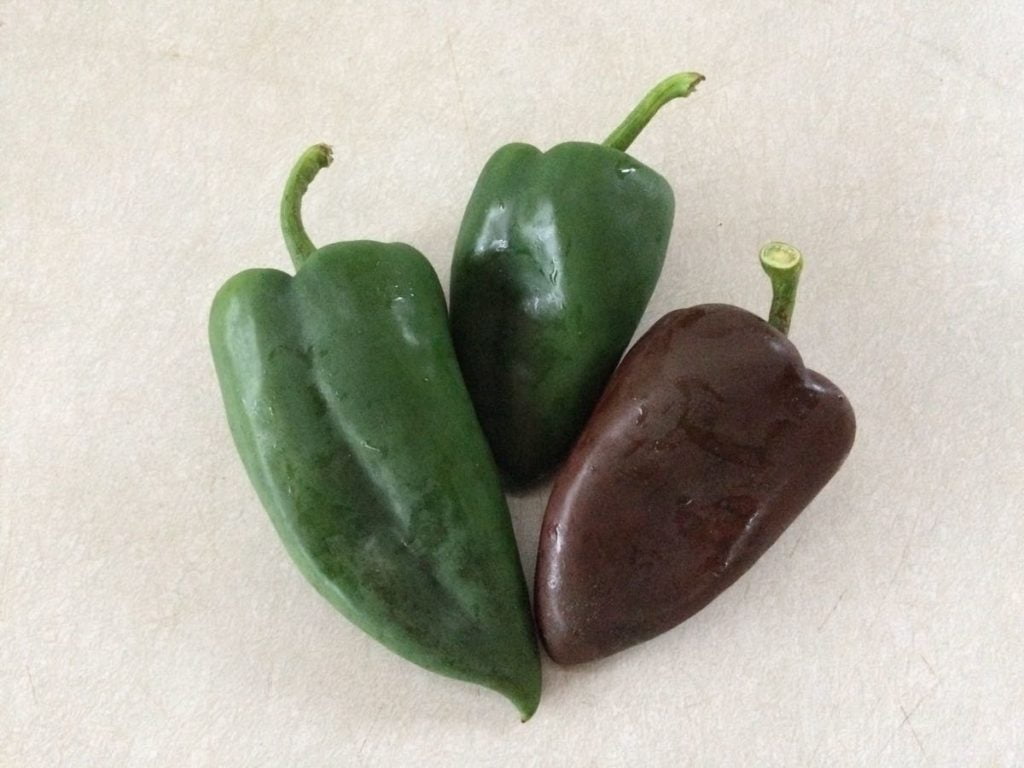
Poblano chiles will be dark green, occasionally with red streaking or a red tip. These are the only hot peppers in this week’s box. All other peppers are sweet.
RECIPES by DEB
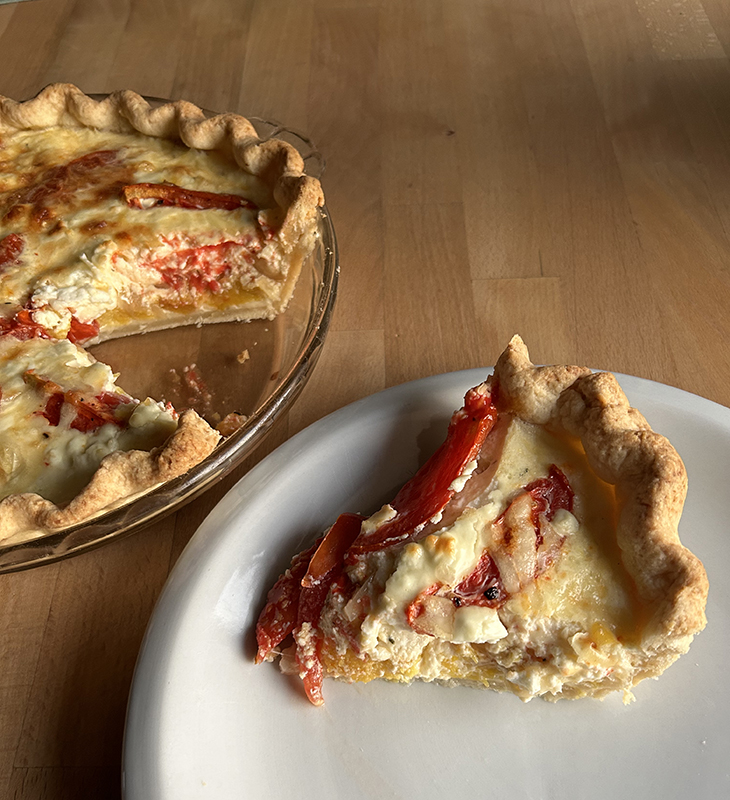
Photo by debslunch
Roasted tomato and squash quiche
This quiche is made with peeled squash but the varieties of winter squash, like acorn and jester, that have ridged shells can be hard to peel when raw. It’s a lot easier to remove the skin after the squash is cooked, so that’s what I’ve done here. And roasting the tomatoes concentrates the juices and makes then even sweeter. I’ve used Provolone cheese and a bit of goat cheese, but feel free to sub in other cheeses to your taste.
Takes: about an hour, but can be done in stages
Serves: 6-8
Ingredients:
Crust for a single crust, 9-inch pie, store bought or here’s a recipe
One medium size acorn-type squash
2 slicing tomatoes, cut into wedges, then chunks OR 2-3 plum tomatoes cut into wedges
salt and freshly ground pepper
Approximately 2 tablespoons olive oil
1 cup thinly sliced onion
1 tablespoon butter
1/2 teaspoon dried thyme, or 1-2 tablespoons fresh herbs, basil or parsley suggested
1 cup provolone or other good melting cheese, grated
about an ounce of soft goat cheese, optional
3 eggs
about 1 1/4 cups half and half
extra fresh herbs for garnish, optional
- Make your crust and chill – this can be done the day before – or even several days before. Roll out the crust – or unfold purchased crust – and fit it into a deep 9-inch pie dish. Set the crust in the fridge while you make the filing.
- Line one large baking sheet, such as a half sheet pan that’s 18 x13, or two smaller ones, with parchment. Heat the oven to 400°. Arrange the tomatoes on one end of the baking sheet, or on one of your smaller baking sheets. Cut the squash in half and scoop out the seeds. Cut each half of the squash into wedges, and arrange on the other end of a large baking sheet, or separately on a smaller baking sheet. Salt the vegetables, and grind black pepper over. Drizzle with the olive oil and toss – you might not use the full 2 tablespoons. Flip the tomatoes so the cut sides are up. Here’s a pic of the vegetables on a half sheet pan ready for roasting. Place in the oven and roast for 20-30 minutes until the squash is soft and the tomatoes have released their juices. Remove from the oven and cool. This can be done several hours ahead.
- Melt the butter in a skillet and add the onions. Cook over medium high heat, stirring occasionally, until the onions are slightly caramelized, about 10 minutes. At the end of the cooking time, stir in the thyme or fresh herbs, and remove from the heat. While the onions cook, peel the cooked squash – I find this easiest to do with a spoon, creating rough wedges of cooked squash.
- Assemble the quiche: Heat the oven to 425°, and put one rack near the bottom and the other about in the middle. Spread 3/4 of the grated cheese on the bottom of the crust, then lay the squash over the cheese, breaking it into chunks with your fingers. Add the onions on top of the squash, then the tomatoes, and finish with the last 1/4 of the grated cheese.
- Beat the eggs in a 2-cup glass measuring pitcher until they’re well-blended, then add enough half and half to get to the 2 cup mark. Crumble in the goat cheese if using, mix well, and pour the egg mixture over the veggies in the quiche shell.
- Place the quiche on the bottom rack and bake for 15 minutes. After 15 minutes, move the quiche up to the upper rack, and reduce the heat to 375°. Bake until slightly puffed and golden, about 25 minutes. Cool for 10-15 minutes for easiest slicing. Garnish with the optional fresh herbs and serve.
Asian Ground Turkey and Green Bean Stir Fry | Eat Yourself Skinny
From Eat Yourself Skinny
Here’s a quick way to turn our green beans into a dinner entree, even if you’re not trying to eat yourself skinny! Ground turkey is used here, but you could easily sub pork or chicken or even tofu if you prefer. Crumble the tofu and fry in a little oil till golden the same as you would for the meats. Adding some our bell peppers, thinly sliced, when you sauté the green beans would be tasty, and you can also add a couple of tablespoons of peanut butter with the other sauce ingredients to enrich the sauce.
.
.
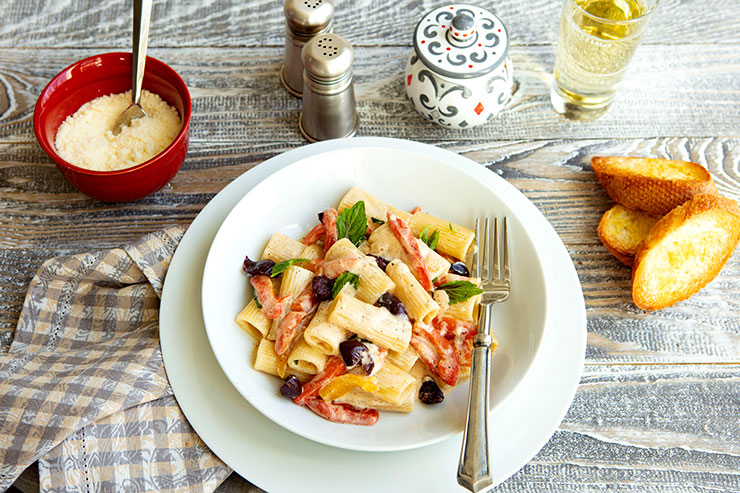
Pasta With Goat Cheese & Roasted Peppers For Mom | Italian Food Forever
From Italian Food Forever
The author of this recipe developed it in memory of their mother. They give you the option of using jarred roasted peppers, while noting that freshly roasted peppers will taste better. I agree, and since the recipe doesn’t provide instructions for roasting peppers, here’s the method I prefer: Place whole peppers on a baking sheet and broil in the oven, watching carefully and flipping the peppers till all sides are charred. Transfer the peppers to a heat proof bowl and cover with a plate or a lid. Allow the peppers to steam for about 15 minutes to loosen the skins and cool so you can handle them! Angle a cutting board so it drains into your sink, and lay the first pepper on the board. Carefully split the pepper, letting any hot juices drain into the skin. Working with half a pepper at a time, scrape out the seeds and veins and pull off the skin. For easy cleanup, you can line the baking sheet with foil, or use a foil pan – parchment tends to burn under the broiler.
.
.

Quick Tomato Vinaigrette | A Couple Cooks
From A Couple Cooks
Here’s a quick salad dressing made with fresh tomato (rather than the usual ketchup or tomato paste). It would be tasty dressing a salad of steamed green beans on a bed of shredded Romaine, topped with garlic croutons.
.
.
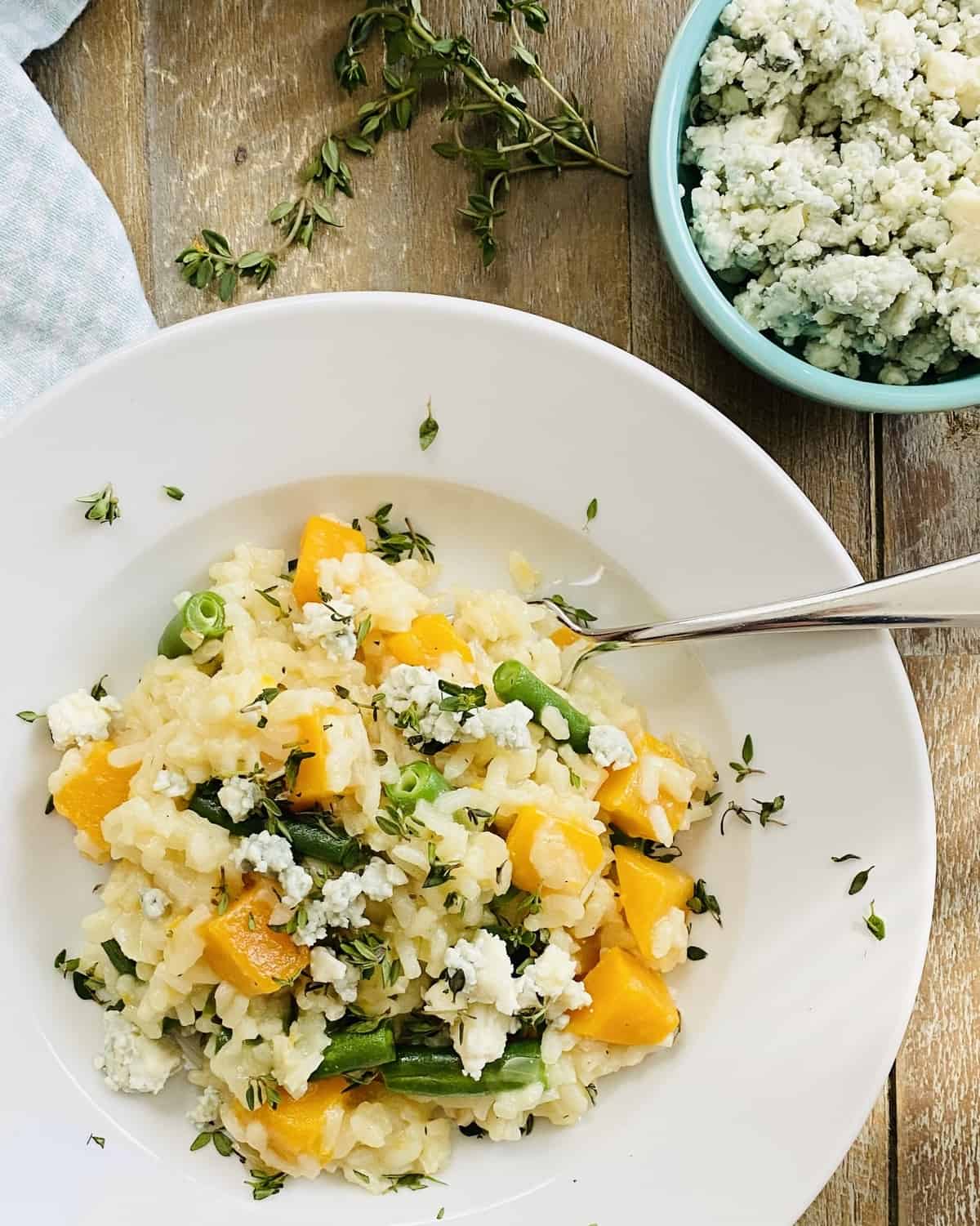
Easy Risotto Recipe with Butternut Squash and Green Beans | amycaseycooks
From amycaseycooks.com
This no-stir risotto recipe uses butternut squash, but you can use the acorn-type squash we get this week. Either try the cook-before-peeling method above, OR halve the squash, seed, cut into wedges, and peel each wedge with a vegetable peeler or a sharp knife, and be sure to choose the least ridge-y of your squash allotment. If using cooked squash add it near the end of the cooking time, otherwise the squash will blend into the risotto. It will still taste good, but it will be invisible. The risotto can be made vegetarian by using vegetable broth instead of chicken.
.
.
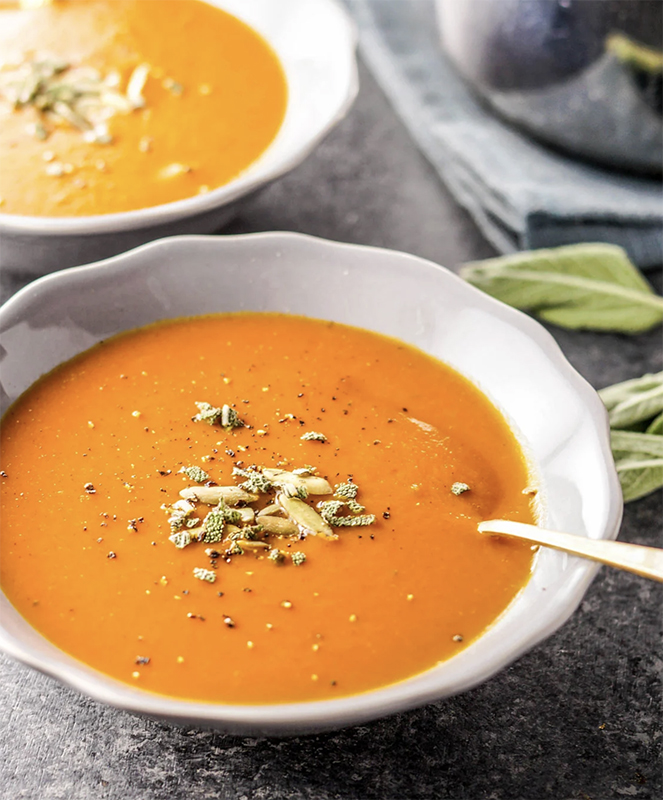
Vegan Creamy Pumpkin Tomato Soup | Detoxinista
From Detoxinista
Anything that can be made with pumpkin can of course be made with winter squash, and that’s certainly the case with this creamy vegan soup. To sub squash for the pumpkin puree in the recipe, simply roast the squash and scoop out the flesh and mash or puree in a food processor. Measure 1 cup of puree and save the rest for another use. The recipe calls for strained tomatoes, a type of tomato puree. To use fresh tomatoes in place of strained, peel and seed fresh tomatoes, and you could either puree the tomatoes first or add to the onions and garlic, since everything in this soup is blended. You can also sub basil for the fresh sage. I found several pumpkin-tomato-coconut soups, and this version from the Washington Post sounds appealing, but you need to sign up for a free account to view if you are not a subscriber.
.
.

Coconut Fish Curry | Blue Apron
From Blue Apron
In this recipe from the Blue Apron meal kit service, the Koji greens and basil from our box work perfectly in place of baby bok choy and Thai basil. Use any of the bell peppers, and you can add some Poblanos in addition or in place of the bell peppers for a little heat.
Week #18; Winter squash primer
- On: September 13, 2023
 0
0
Winter Squash Primer
We expect to have a steady supply of winter squash for the rest of the season. Let’s review some basics.
Expected life: Some winter squash varieties are ready to eat soon after harvest, others store deep into winter. Check our newsletter each week for storage information about squash delivered that week. For example, this week’s acorns are cured and ready to eat. Plan to eat this early variety within two weeks of delivery.
Storage: Do not refrigerate! Winter squash store best at room temperature with good air circulation. No cooler than 50 degrees. On your kitchen counter is good, where you can keep an eye on them. If you see deterioration, cook promptly. These early squash are not intended for storage. Do not cover – that promotes mold.
To make squash easier to cut: Microwave on high for 30 to 60 seconds, depending on size of the squash. This will soften the rind and flesh, making it much easier to cut.
Beth’s favorite simple preparation (acorn or butternut): Winter squash are easily roasted in a 400F oven. The goal is to get brown, caramelized edges.
– Split in half with a sharp knife.
– Scoop out and discard seeds.
– Run the squash briefly under running water, then shake off the excess water. Place cavity-side-down on an oiled baking sheet. The little bit of moisture seals the squash to your roasting pan. The water soon evaporates, allowing the squash to brown and caramelize. Caramelization really boosts the flavor.
– Roast at 400F until easily pierced with a fork, 30 – 45 minutes depending on size. Flip over while hot. Add a little butter to melt and some seasoned salt. Cut into wedges and eat.
Stuffed squash
Acorn squash have a central cavity perfect for stuffing. Prepare your favorite fully-cooked stuffing, e.g. a rice or quinoa mixture. Roast your squash as described below. Preheat the stuffing. Fill the cooked squash with stuffing, top with grated cheese and return to the oven until everything is hot.
Can you eat the rind? In my opinion, rinds on these acorn squash are too tough to eat. Steve eats the Jester rind. I do not.
We pick, you wash. We are hustling to bring in our fall crops and don’t have time to wash the winter squash. We are busy! Please help by washing your squash!
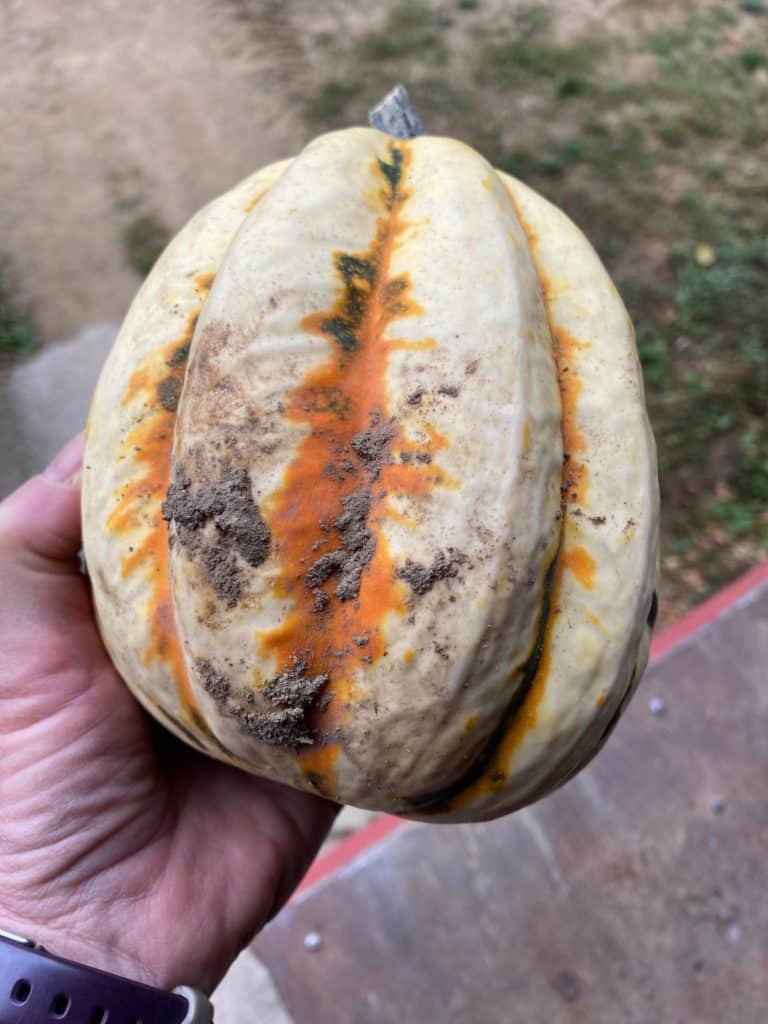
Please wash your squash to remove any soil. But let’s pause to ooh and ahh over that bright orange ground-spot. That predicts a really tasty squash.
Veggie List & Veggie Notes
Week #18, September 14/15, 2023
– Weekly shares
– BiWeekly/ green
– Sampler/ B group
‘Jester’ acorn squash, ~2
Bok choy
Red watermelon
Colored peppers, 3 (or 4), bell &/or frying
‘Oranos’ snack peppers, several
Slicing tomatoes and/or plum tomatoes, ~3.25 lb
(Both types of tomatoes will be in the same bag.)
Zucchini or yellow squash, ~1 count (or 2)
Yellow onion
Basil
By site: globe eggplant OR another pepper OR another zucchini OR a bigger watermelon.
Next week’s box will probably contain green beans, winter squash, tomatoes, peppers, cooking greens, and more.
Watermelon – This is the last melon of the season. We are sending small red watermelons this time, either ‘Dark Belle’ (oblong) or Mini Love (round).
‘Jester’ acorn winter squash – You will receive one or two squash. All are cured, ready to eat, and tasty. Eat within two weeks, as they are less reliable after that; acorn squash are not meant for storage. Plus, we will send more next week! Skins of these types are not edible. It’s best to cook the squash, then remove the skins, eg by scooping while eating.
Storage: Store at room temperature for two weeks but keep an eye on your squash and cook promptly if they start to deteriorate.
Bok choy (rosette with thick white stems and green leaves) – This Asian green is good for stir-frying or sautéing or in soup. You can think of the stems and leaves as two separate vegetables. The stems require longer cooking. The leaves will cook almost as quickly as spinach. Bok choy stores well, so feel free to pull off leaves as you need them, or use the whole head at once.
Storage: Refrigerate in a plastic bag or other container.
Tomatoes – Keep a close eye on your tomatoes and eat soon. It’s fall now, with cooler nights, and the tomato plants are weakening. If your tomatoes start to show flaws, go ahead and refrigerate them to slow the decline. It’s better to sacrifice a little flavor.
Zucchini or yellow squash – This is the last of the season.
Yellow onion – This is a pungent cooking-type onion.
RECIPES by PHOEBE
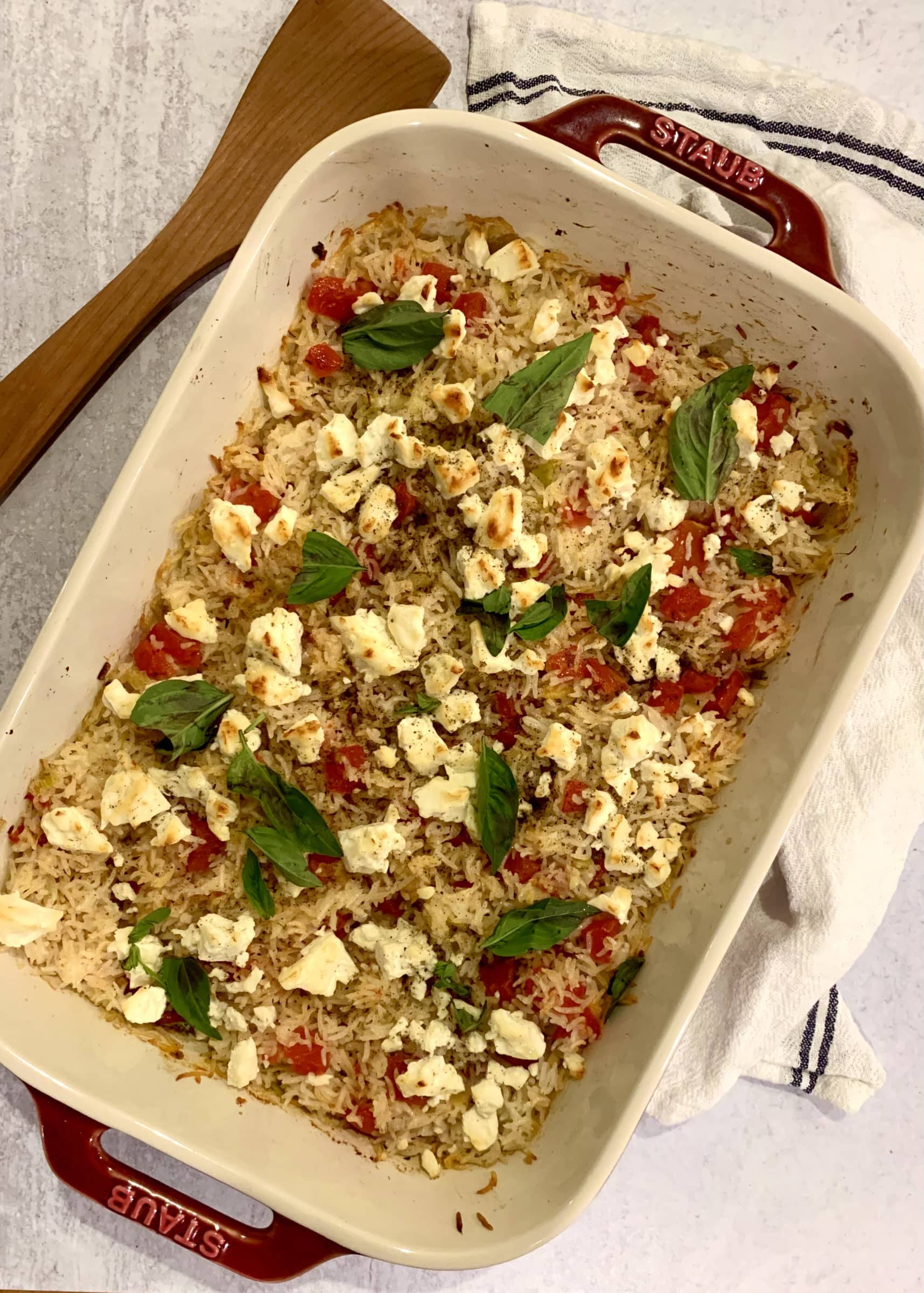
Baked Rice with Tomatoes and Feta
If you’ve ever struggled to cook perfect rice on the stove, then you have to try baking it in the oven! The technique couldn’t be simpler, and the rice comes out with a wonderful light and fluffy texture. In this recipe, I mix aromatic onions and garlic, cumin seeds, lemon zest, and juicy tomatoes into the rice to create a more substantial side dish or vegetarian main. A layer of broiled feta adds delicious richness and tangy flavor. Recipe adapted from Yotam Ottolenghi’s baked rice.
Serves 6 to 8
Prep time: 20 minutes
Cook time: 40 minutes
¼ cup extra-virgin olive oil
½ onion, thinly sliced
3 garlic cloves, minced
1 teaspoon cumin seeds
1 tablespoon lemon zest, plus lemon wedges for squeezing
2 cups chopped fresh tomatoes
1½ cups basmati rice, rinsed
½ teaspoon sea salt, plus more to taste
2¼ cups boiling water
6 ounces feta cheese, roughly crumbled
Za’atar, for garnish, optional
Fresh basil, for garnish
Preheat the oven to 425°F.
Heat the olive oil in a large skillet over medium heat. Add the onion and a pinch of salt and cook, stirring occasionally, until softened, about 5 minutes. Stir in the garlic, cumin seeds, and lemon zest and cook, stirring, until fragrant, another 30 seconds to 1 minute. Remove from the heat.
Transfer the onion mixture, including all the oil and seasonings, to a 9×13-inch baking dish. Spread in an even layer. Top with the tomatoes and evenly sprinkle with the rice. Season with the salt.
Pouring the boiling water over the rice, then immediately cover the baking dish tightly with foil. Transfer to the oven and bake for 30 minutes, or until the water is absorbed. Let the dish sit, covered, for 5 minutes at room temperature.
Turn the oven broiler to high.
Uncover the rice and fluff with a fork, mixing the rice, tomatoes, and onions together. Spread in an even layer, then scatter the feta on top. Broil for 3 to 8 minutes, or until the cheese is browned around the edges.
Remove from the oven, squeeze with lemon juice, and garnish with pinches of za’atar, if using, and fresh basil. Season to taste and serve.
.
.
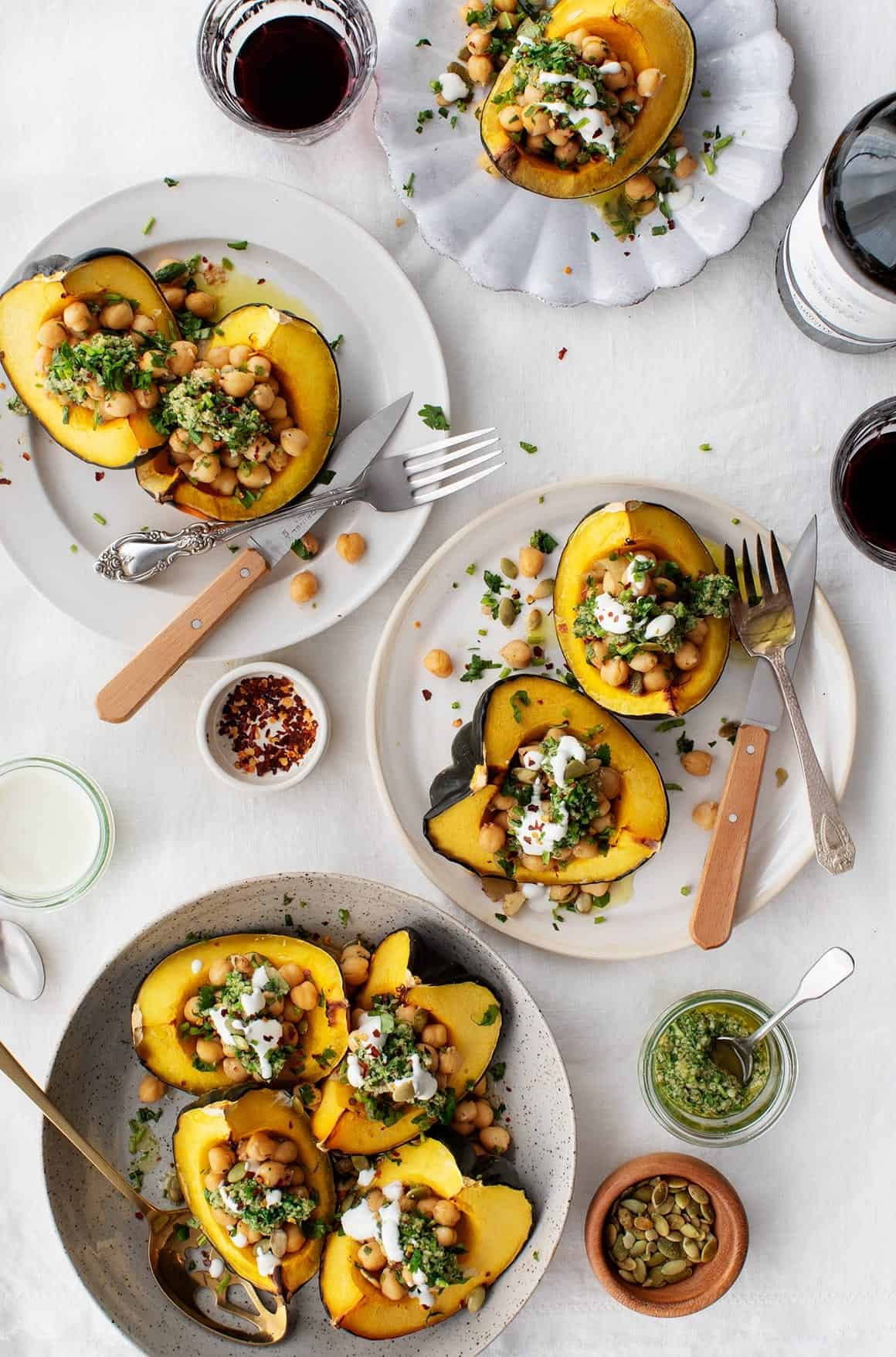
Photo by Jack Mathews and Jeanine Donofrio
Acorn Squash with Chickpeas and Chimichurri
From Love & Lemons
In this flavorful fall recipe, warmly spiced chickpeas fill tender boats of roasted acorn squash. The vibrant green sauce on top is a nontraditional cilantro chimichurri. Substitute basil to feature the contents of your share.
.
.
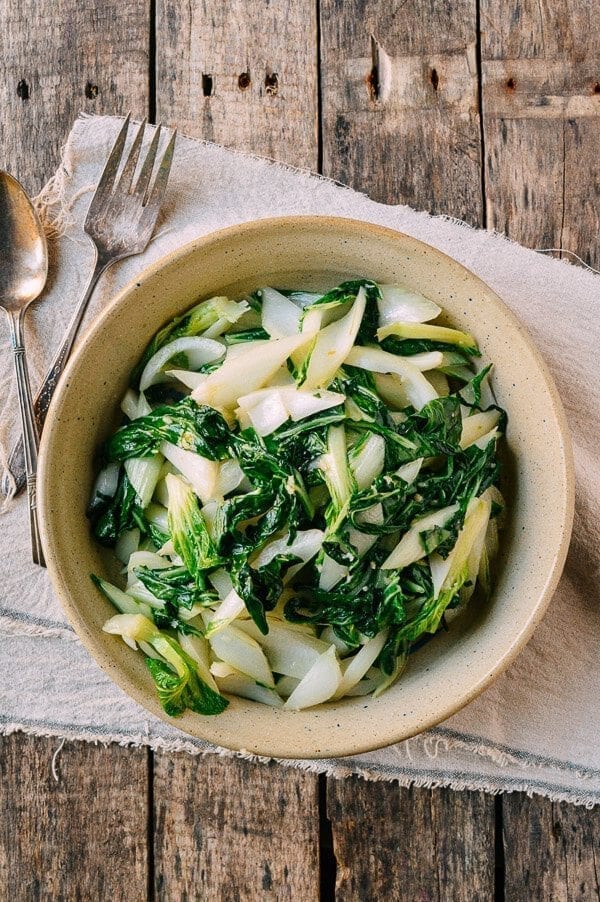
Photo by The Woks of Life
Stir-Fried Bok Choy
From The Woks of Life
Pair this quick stir fry with any simply cooked protein and a scoop of rice for an easy, healthy meal.
.
.
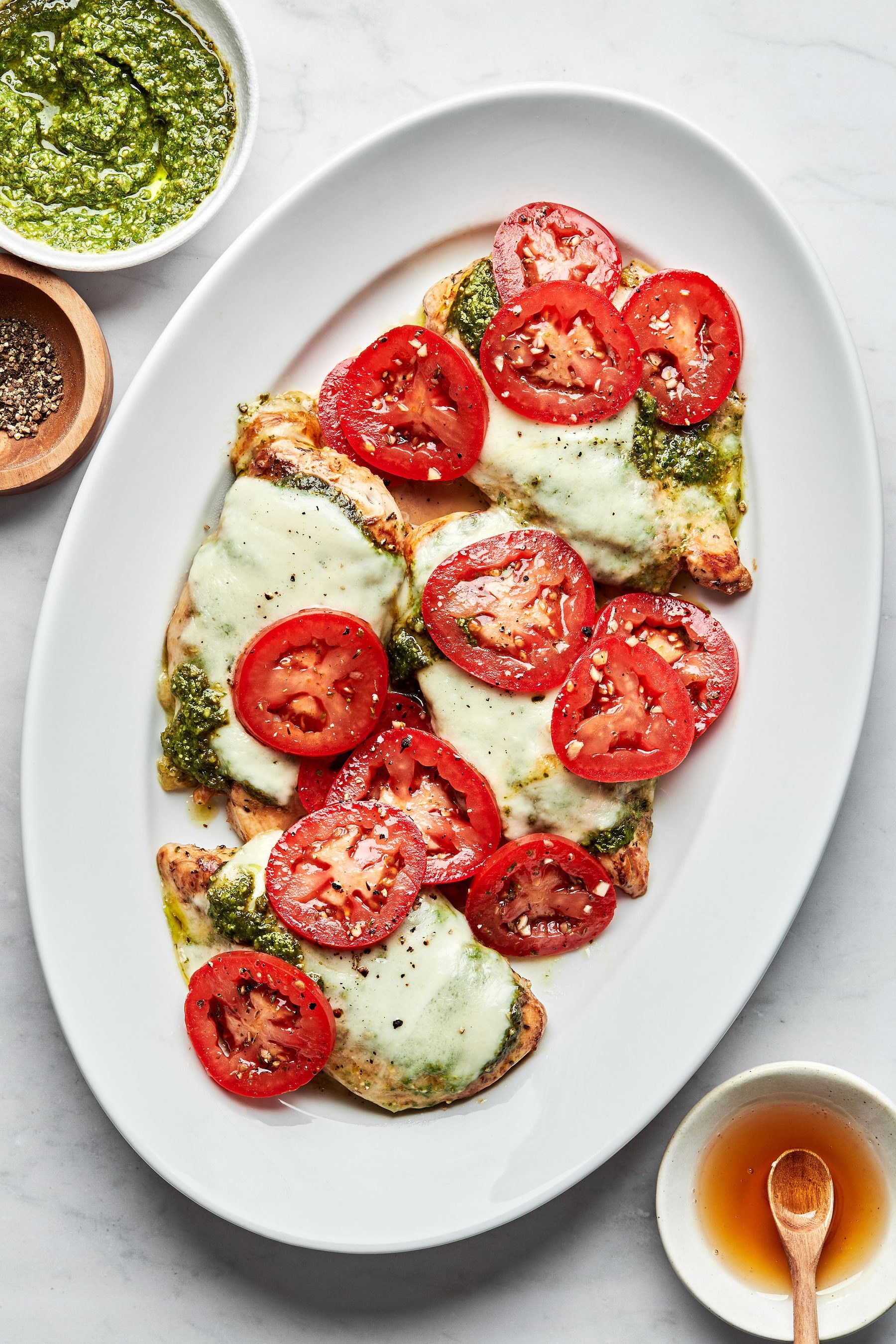
Photo by The Modern Proper
Chicken Caprese
From The Modern Proper
Homemade pesto is always a great use for fresh basil! While it’s delicious on pasta, you can do so much else with it too. For instance, enjoy it in this chicken Caprese recipe with some of the tomatoes from this week’s box.
.
.
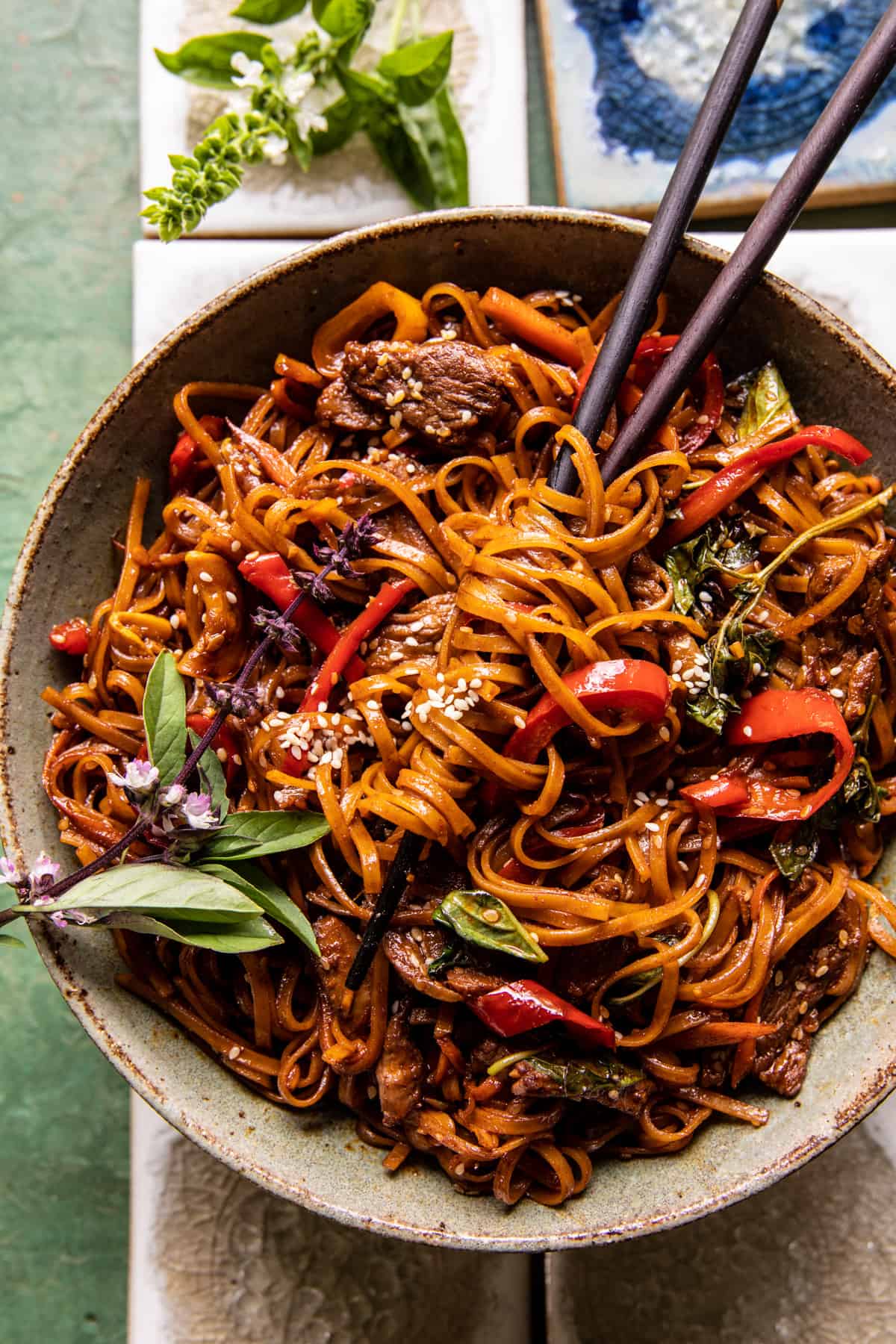
Photo by Half Baked Harvest
20-Minute Korean Beef Sesame Noodles
From Half Baked Harvest
This weeknight noodle recipe calls for “3 cups mixed stir fry vegetables,” which makes it a great match for the contents of this week’s box! Toss in chopped bok choy, thinly sliced peppers, and/or zucchini, and garnish it all with fresh basil. If you don’t have shallots on hand, replace them with thinly sliced onions and increase the cooking time as needed.
.
.

Photo by Eva Kolenko
Tomato Galette
From Love & Lemons
This comforting recipe is perfect for the tail end of tomato season, when the temperatures get cool enough to turn on the oven. It calls for heirloom tomatoes, but both Tipi’s slicers and plum tomatoes would work nicely here. Omit the chives if you don’t have any on hand, and substitute 1 teaspoon dried thyme for the tablespoon fresh.
.
.

Photo by Dishing Up The Dirt
Pumpkin Chili
From Dishing Up The Dirt
Ready for soup season? Make this hearty pumpkin chili with the squash and peppers in this week’s share! Feel free to omit the jalapeño—you can add a pinch of cayenne if you’d like the chili to be spicy.




